7 Great Depression
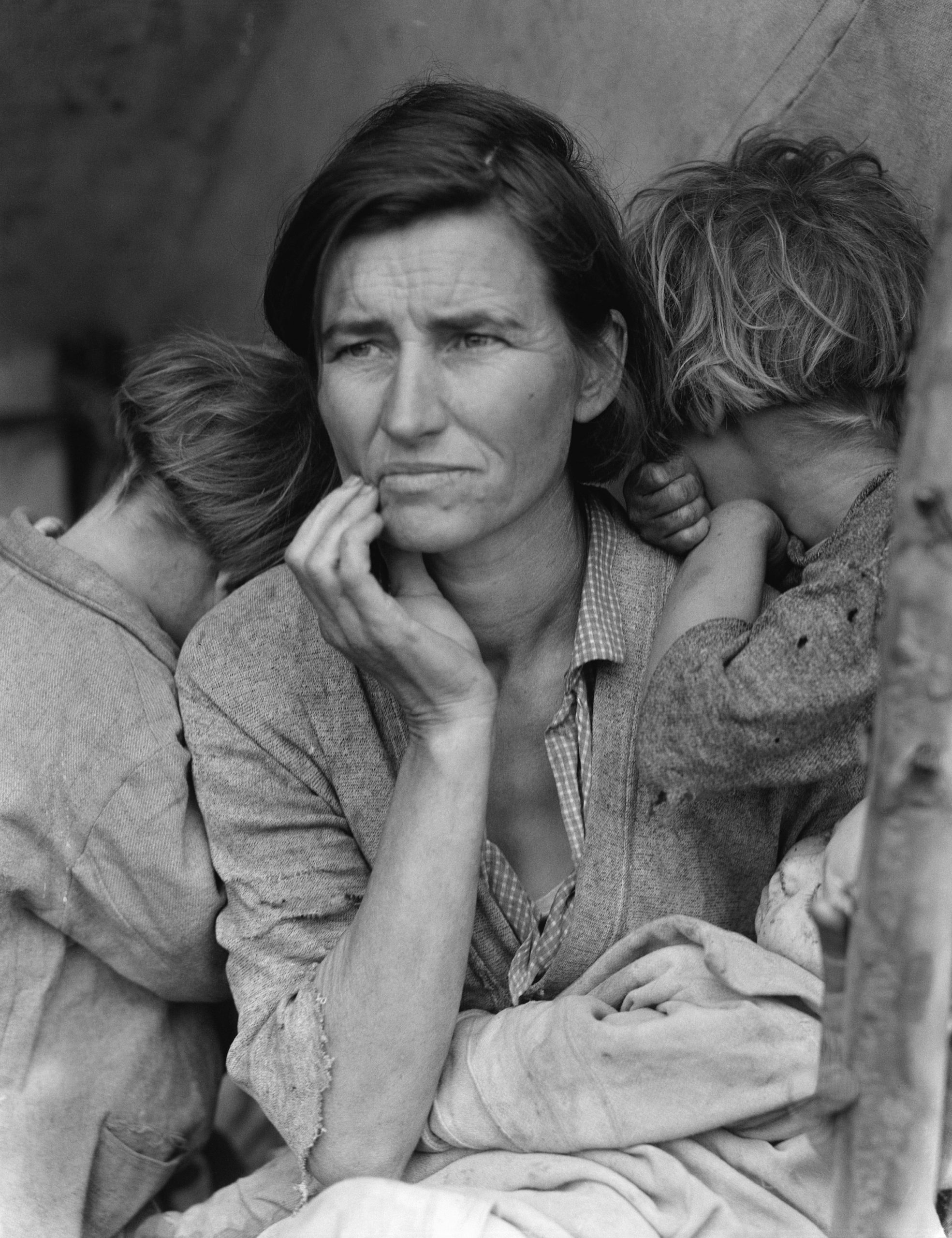
Origins
Although the belief that economic prosperity was universal was exaggerated at the time and has been overstated by many historians, excitement over the stock market and the possibility of making speculative fortunes permeated popular culture in the 1920s. A Hollywood musical, High Society Blues, captured the hope of instant prosperity. Ironically, the movie didn’t reach theaters until after the market crash. “I’m in the Market for You,” a musical number from the film, used the stock market as a metaphor for love: You’re going up, up, up in my estimation / I want a thousand shares of your caresses, too / We’ll count the hugs and kisses / When dividends are due / ’Cause I’m in the market for you. But just as the song was being recorded in 1929, the stock market reached its peak, crashed, and brought an abrupt end to the seeming prosperity of the Roaring Twenties. The Great Depression had arrived.
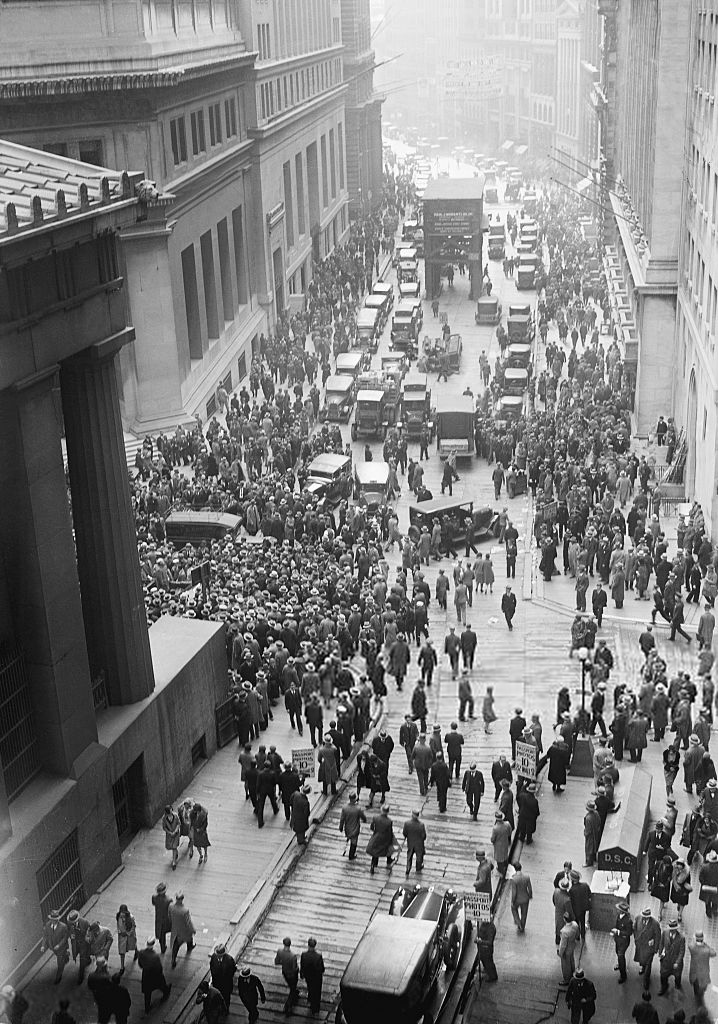
The exact causes of the Stock Market Crash that began the Great Depression is still being debated by economists and historians, but most agree that a huge speculative bubble had formed during the Roaring Twenties. Although most Americans had little savings and only the richest 2.5 percent invested in stocks, those who did often borrowed to do so. Most stock purchases were made on “margin”, which meant shares could be bought with money borrowed from brokers. Often, margin accounts allowed buyers to borrow 90% to 95% of the money they needed to complete a transaction. That meant a speculator could buy $1,000 in shares for $50 or $100. This was a great deal if the value of the shares rose quickly. If a trader could make a 10% gain on $1,000 in shares (or $100) that had only cost her $50 and a couple of dollars in interest on the loan, she would be way ahead. And share prices seemed to be rising steadily. One reason for this, of course, was the demand generated by all this margin buying, which also meant that everybody was able to buy ten to twenty times more shares than they could actually afford.
The problem with margin buying was that share prices were not guaranteed to rise forever. Just as the potential to profit was leveraged, so was the potential to lose money. A ten percent downward move in the price of the stock would mean the speculator lost $100 on that same investment of $50. By the rules of most brokers, the trader would receive a “margin call” once she had lost more than she had actually invested, asking her to pay the money borrowed if she wanted to hold onto the shares. Most speculators did not want to (or weren’t able to) cover these margin calls, so the stocks would be sold at a loss, to prevent further losses. An avalanche of selling to cover margin positions once the market turned, drove the stock prices down even more rapidly. The bubble that had been inflated by margin speculation burst in the fall of 1929.
On Thursday, October 24, stock market prices plummeted. Ten billion dollars in investments (equivalent to about $100 billion today) disappeared in a matter of hours. Panicked selling set in as thousands of positions were closed to cover margins. Stock values sank to sudden lows, and stunned investors crowded the New York Stock Exchange demanding answers. The Dow Jones Industrial Average began Thursday at 305, but dropped fast on volume three times greater than normal. New York’s leading bankers met at the Wall Street offices of J. P. Morgan & Co., across the street from the exchange and raised millions in personal and institutional funds to halt the slide. The market stabilized and closed at 299. On Friday the Dow actually rose above the price it had opened on, Thursday. But fears spread over the weekend and the following Monday frightened investors dumped their portfolios to avoid further losses, dropping the Dow to 260. On October 29, Black Tuesday, the stock market began a fall that would continue for three years. Stock values evaporated and the Dow dropped to 230. It kept dropping until 1932, finally reaching a bottom at 41. The American economy lost 90% of its value, and the stock market would not reach the level it had seen in September 1929 for another twenty-five years. Shares of U.S. Steel dropped from $262 to $22. General Motors stock fell from $73 a share to $8. Over 80% of John D. Rockefeller’s fortune—the greatest in American history—vanished.
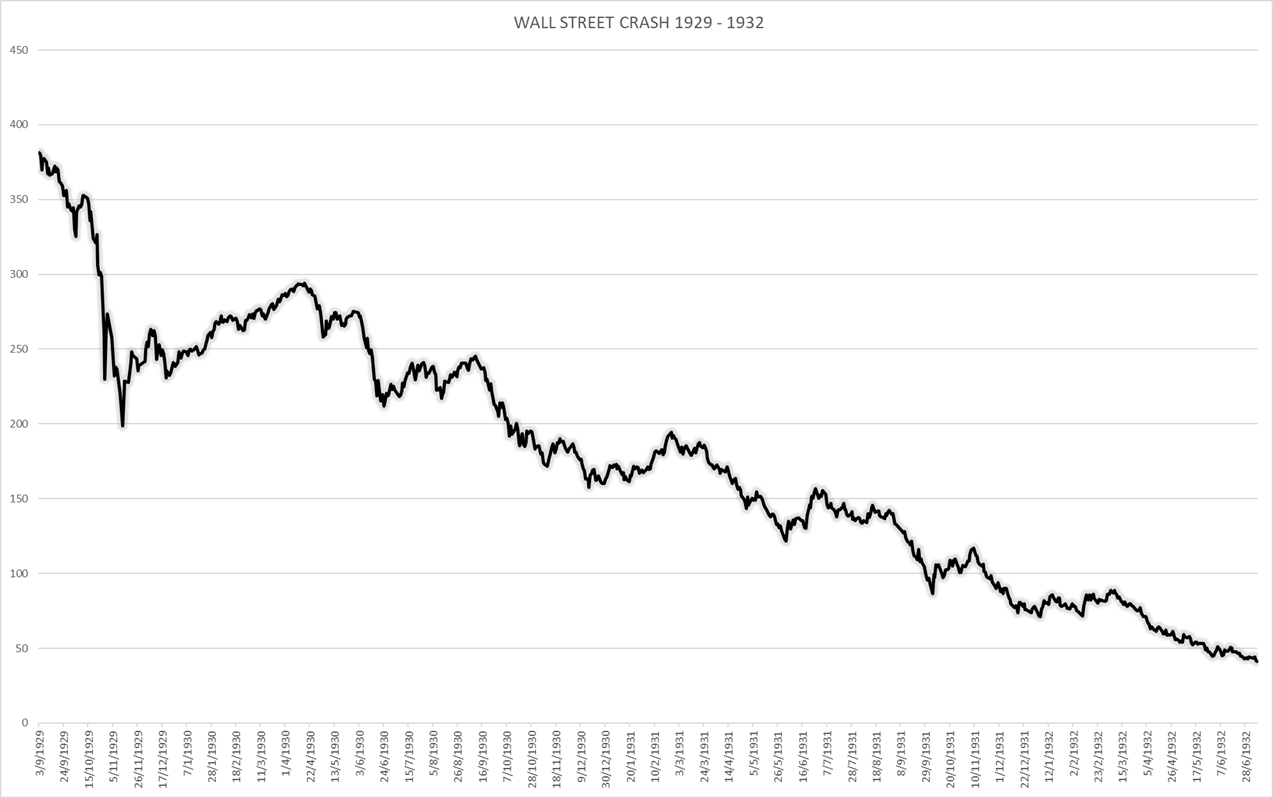
Although the crash stunned the nation, it exposed deeper, underlying problems with the American economy in the 1920s. The stock market’s rise did not really represent the health of the overall economy, and the overwhelming majority of Americans had no personal stake in Wall Street. The market’s collapse, no matter how dramatic, did not by itself destroy the American economy. Instead, the crash exposed factors such as rising inequality, declining demand, rural collapse, overextended investors, and a bursting speculative bubble that all combined to plunge the nation into the Great Depression. Despite resistance from Populists and Progressives, the gap between rich and poor had widened throughout the early twentieth century. In the aggregate, Americans were better off in 1929 than in 1919 and both production and consumption had grown. Per capita income had risen 10% for all Americans in the 1920s, but 75% for the wealthiest. The return of conservative politics in the 1920s had reinforced federal policies that exacerbated this divide. High import tariffs, low corporate and personal taxes, easy credit and low interest rates overwhelmingly favored wealthy investors who spent their money on luxury goods and speculative investments in the rapidly rising stock market.
The pro-business policies of the 1920s were designed for an American economy built on the production of durable goods such as household appliances and cars. In the 1920s, industry was unable to keep producing at that pace. The boom of automobile manufacturing, the biggest driver of the American economy in the 1920s, slowed as the market became saturated and fewer Americans able to afford a car had not already bought one. Cars like the Ford Model T were sturdy and durable, so they did not need to be replaced every few years. Manufacturers scaled back production and laid off workers, stripping potential consumers of cash and blunting demand for consumer goods, which increased the downward economic pressure. The situation was compounded by increased automation and rising efficiency in American factories, which boosted corporations’ profits but hurt workers. Despite impressive financial growth throughout the 1920s, unemployment hovered around 7 percent throughout the decade, suppressing purchasing power for large numbers of potential consumers.
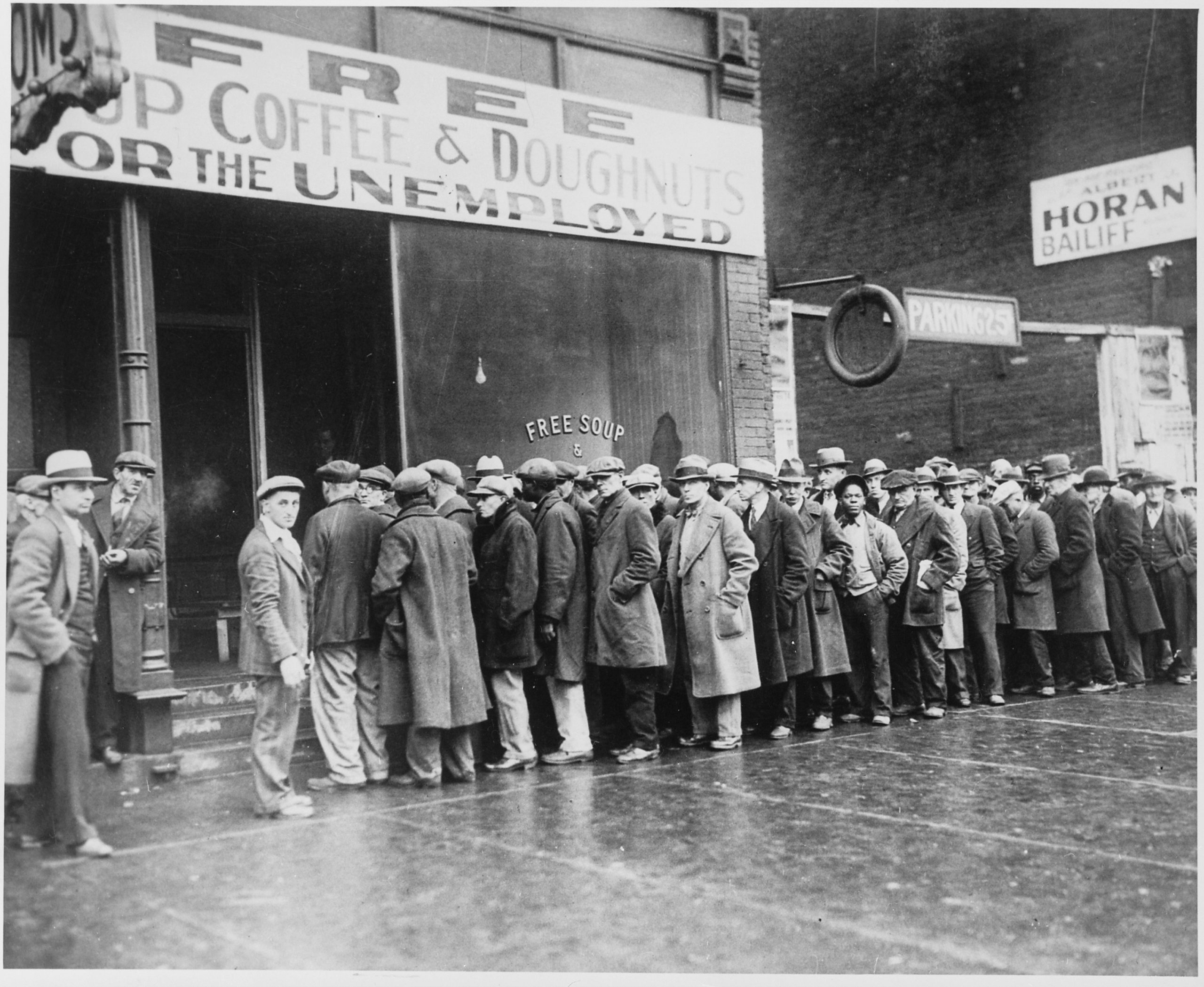
And for American farmers, hard times had begun long before the markets crashed. The war years had been good for farmers, when Europeans ate food shipped from America. Farmers increased production and many new farmers entered the market and plowed new fields; often on marginal land, as we will discuss below. In the early 1920s, wartime demand disappeared and farm prices began a long decline as both domestic and international demand for cotton, foodstuffs, and other agricultural products dried up. Widespread soil exhaustion and erosion only compounded the problem. Farmers found themselves unable to make payments on loans they had taken out to expand their acreages and buy equipment during the good years, and banks in agricultural areas tightened credit in response. By 1929, farm families were in a precarious economic position even before the Depression wrecked the global economy.
Question for Discussion
- What were the main causes of the stock market crash?
Hoover and the Politics of the Depression
Despite serious problems in the industrial and agricultural economies, most Americans in 1929 and 1930 believed the nation would bounce back quickly. President Herbert Hoover reassured an audience in 1930 that “the depression is over.” But the president was not simply guilty of false optimism. Hoover had made many mistakes. During his 1928 election campaign, he had promoted higher tariffs to encourage consumption of U.S.-produced products and to protect American farmers from foreign competition. Spurred by the ongoing agricultural depression, Hoover signed the highest tariff in American history, the Smoot-Hawley Tariff of 1930, just as global markets began to crumble. Other countries retaliated and tariff walls rose across the globe. Between 1929 and 1932, international trade dropped from $36 billion to only $12 billion. American exports fell by 78%.
More economic policies backfired. The Federal Reserve overcorrected in their response to margin-based speculation by raising interest rates and tightening credit. Across the country, banks denied new loans and called in existing debts. Their patrons, afraid these tough credit policies meant further financial trouble, rushed to withdraw money before institutions could close their doors. “Runs” on these banks ensured their fate. Bank runs had not been uncommon in the 1920s; but in 1930, with the economy worsening and panic from the crash accelerating, 1,352 banks failed. In 1932, nearly 2,300 banks collapsed, taking credit, personal deposits, and people’s life savings with them.

The Great Depression was the result of problems that had been building up since the beginning of the century. Fiscal policies of the Republican “business presidents” widened the gap between rich and poor and fostered a standoff over international trade, but such policies were popular and widely seen as a source of America’s impressive growth. Few Americans had the foresight to repudiate an age of easy credit, rampant consumerism, and wild speculation. Instead, as the Depression spread, public blame settled on President Herbert Hoover and the Republican Party. Hoover had claimed credit for economic prosperity; now he was blamed for collapse. In 1928 Hoover had believed his presidency would be no different from that of his Republican predecessors, whom he had served as secretary of commerce. Their administrations had been known for government inaction, seemingly rampant prosperity, and high approval ratings. And Hoover epitomized the “self-made man.” Orphaned at age nine, he had graduated from Stanford University in 1895 and become a millionaire as an engineer for multinational mining companies. During World War I he oversaw voluntary rationing as the head of the U.S. Food Administration and after the armistice served as the director-general of the American Relief Association in Europe. After the war both the Democratic and Republican parties had tried to draft him to run for president in 1920.
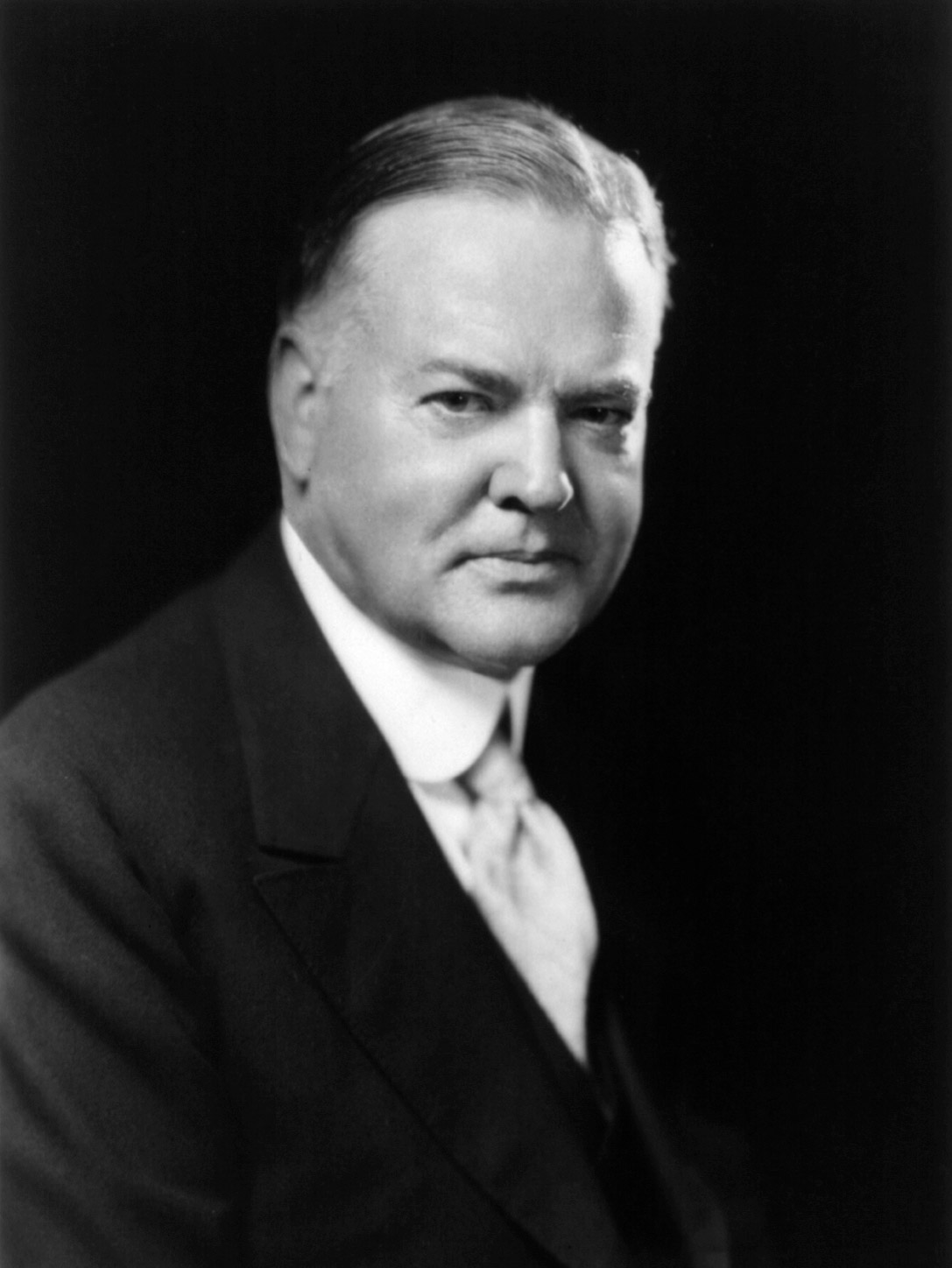
Hoover had declined to run in 1920 and 1924. In 1928, he seemed the natural successor to Coolidge. Politically, aside from religion and Prohibition (he was a “dry,” Catholic Democrat Al Smith was a “wet”), Hoover’s platform differed very little from Smith’s, leaving little to discuss during the campaign except personality and religion. Both benefited Hoover, who won in a landslide, taking nearly 60 percent of the popular vote. Although Hoover is remembered as a “business president” and is given a big share of the blame for exacerbating (if not causing) the Depression, he also embraced a system called associationalism that assumed Americans could build a web of voluntary cooperative organizations to provide economic aid to those in need. Businesses, Hoover believed, would willingly limit harmful practices for the greater economic good. To Hoover, direct government aid would discourage a healthy work ethic while associationalism would encourage the self-control and initiative that fueled economic growth. When the Depression exposed the failure Hoover’s associationalist strategies to produce an economic recovery, he was not flexible enough to recognize the limits of his ideology.
Hoover had entered office with widespread popular support, but by the end of 1929 the economic collapse had overwhelmed his presidency. Hoover and his advisors assumed, and then desperately hoped, that the sharp economic decline was just a temporary downturn; part of the inevitable boom-bust cycles that stretched back through America’s commercial history. Many economists argued that periodic busts culled weak firms and made space for future growth. But when suffering Americans looked to Hoover for help, the president only answered with associationalist volunteerism. He asked business leaders to avoid laying off workers and encouraged state and local charities to assist those in need. Hoover established the President’s Organization for Unemployment Relief (POUR) to help private agencies. While POUR urged charitable giving, relief organizations were overwhelmed by the growing needs of unemployed, underfed, and unhoused Americans. By mid-1932 a quarter of all of New York’s private charities had closed after running out of money. In Atlanta, relief charities could only provide $1.30 per week to needy families. The size and scope of the Depression overwhelmed the capacity of volunteer organizations to fix the crisis. By 1932, with the economy long stagnant and a reelection campaign looming, Hoover grew desperate. Hoping to stimulate American industry, he created the Reconstruction Finance Corporation (RFC) to provide emergency loans to banks, building-and-loan societies, railroads, and other private industries. RFC was radical in its use of direct government aid and out of character for the normally laissez-faire Hoover, but it also bypassed needy Americans to bolster businesses. New York congressman Fiorello LaGuardia captured public sentiment when he denounced the RFC as a “millionaire’s dole.”
Questions for Discussion
- Why did Americans expect President Herbert Hoover would be able to do something about their economic problems?
- What prevented Hoover from taking a more vigorous approach?
The Bonus Army
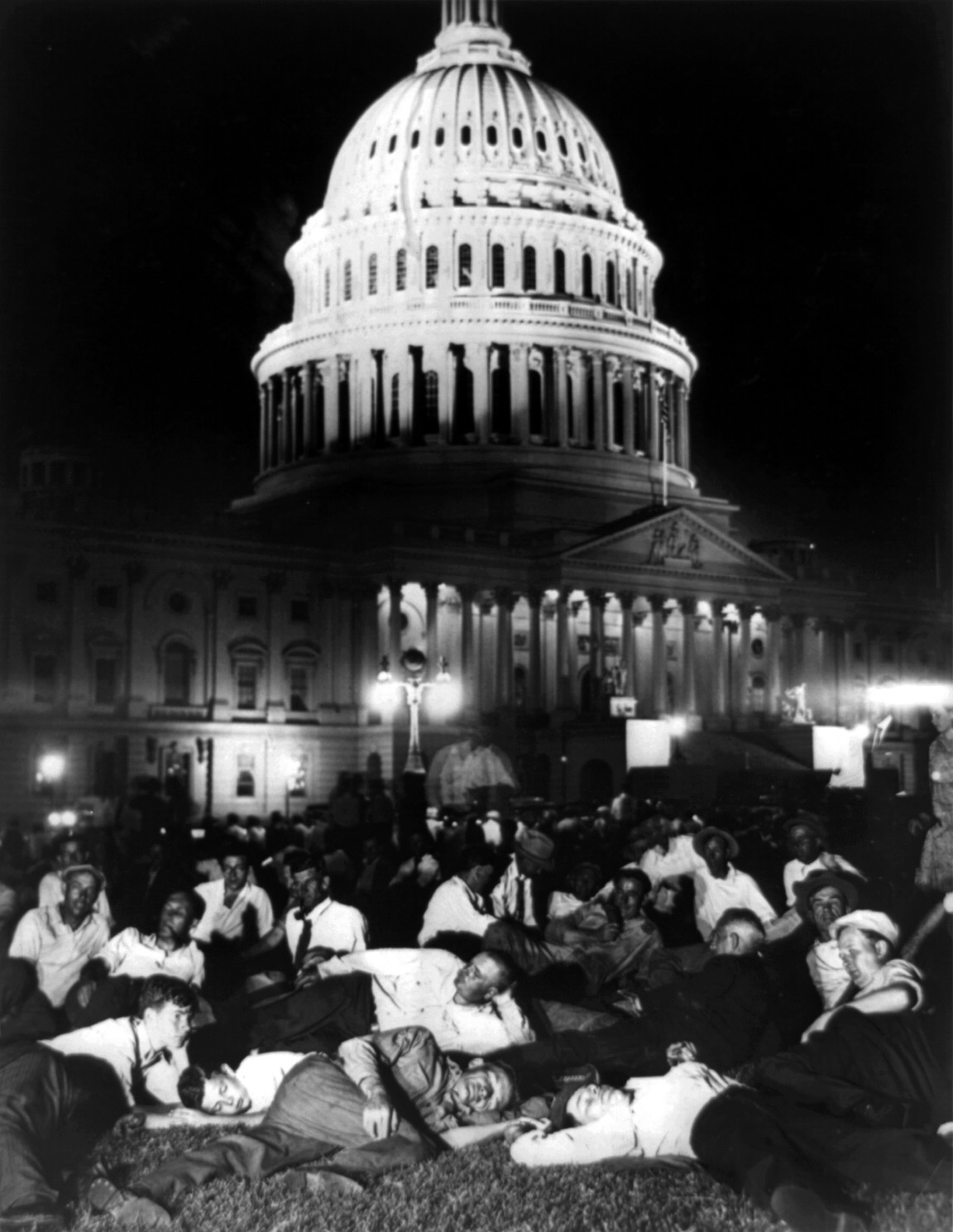
Hoover’s reaction to another public need sealed his legacy. In the summer of 1932, Congress began debating a bill to immediately pay cash bonuses to veterans of World War I. The bonuses had already been agreed upon, but payments had been scheduled for 1945. Given hardships they faced, the veterans asked for an early payment. The bonus symbolized government relief for people Americans considered the most deserving recipients, and from across the country more than fifteen thousand unemployed veterans and their families converged on Washington, D.C. They erected a tent city across the Potomac River, like the “Hooverville” camps of homeless and unemployed Americans appearing in many American cities. Concerned with the impact immediate payment would have on the federal budget, Hoover opposed the bill and although passed in the House of Representatives it was defeated in the Republican-controlled Senate.
While most of the “Bonus Army” left Washington after the bill’s defeat, some stayed in protest. They were unemployed and homeless war veterans, but Hoover called the remaining protesters “insurrectionists” and ordered them to leave. When thousands ignored Hoover’s order, he sent General Douglas MacArthur. Accompanied by local police, the U.S. Army infantry, cavalry, tanks, and a machine gun squadron, MacArthur evicted the Bonus Army and burned the tent city. National media covered the disaster as troops attacked veterans, chased down men and women, tear-gassed children, and torched the shantytown. Several veterans were killed in the attack.
During the Bonus crisis, a war hero named Smedley Butler visited the camp. Major General Butler was the most decorated Marine in U.S. history and had won the Medal of Honor twice. After fighting in the Spanish-American War, the Philippine War, the Boxer Rebellion, and a number of “banana wars” in Central America, Butler had finally come to the conclusion that most of those military actions had been taken for the benefit of corporations. Butler published his thoughts in a book called War is a Racket in 1935. At the Bonus camp Butler warned the veterans not to do anything that would cost them public sympathy, but he told the men they had just as much right to lobby Congress as any corporation. Hoover’s insensitivity toward suffering Americans, his unwillingness to address widespread economic problems, and his repeated platitudes about returning prosperity condemned his presidency. Hoover was not personally responsible for the Depression, just as he had not been responsible for the previous prosperity. But neither he nor his advisors understood the enormity of a crisis his conservative ideology could neither accommodate nor address. As a result, Americans found little relief from Washington until the election of 1932.
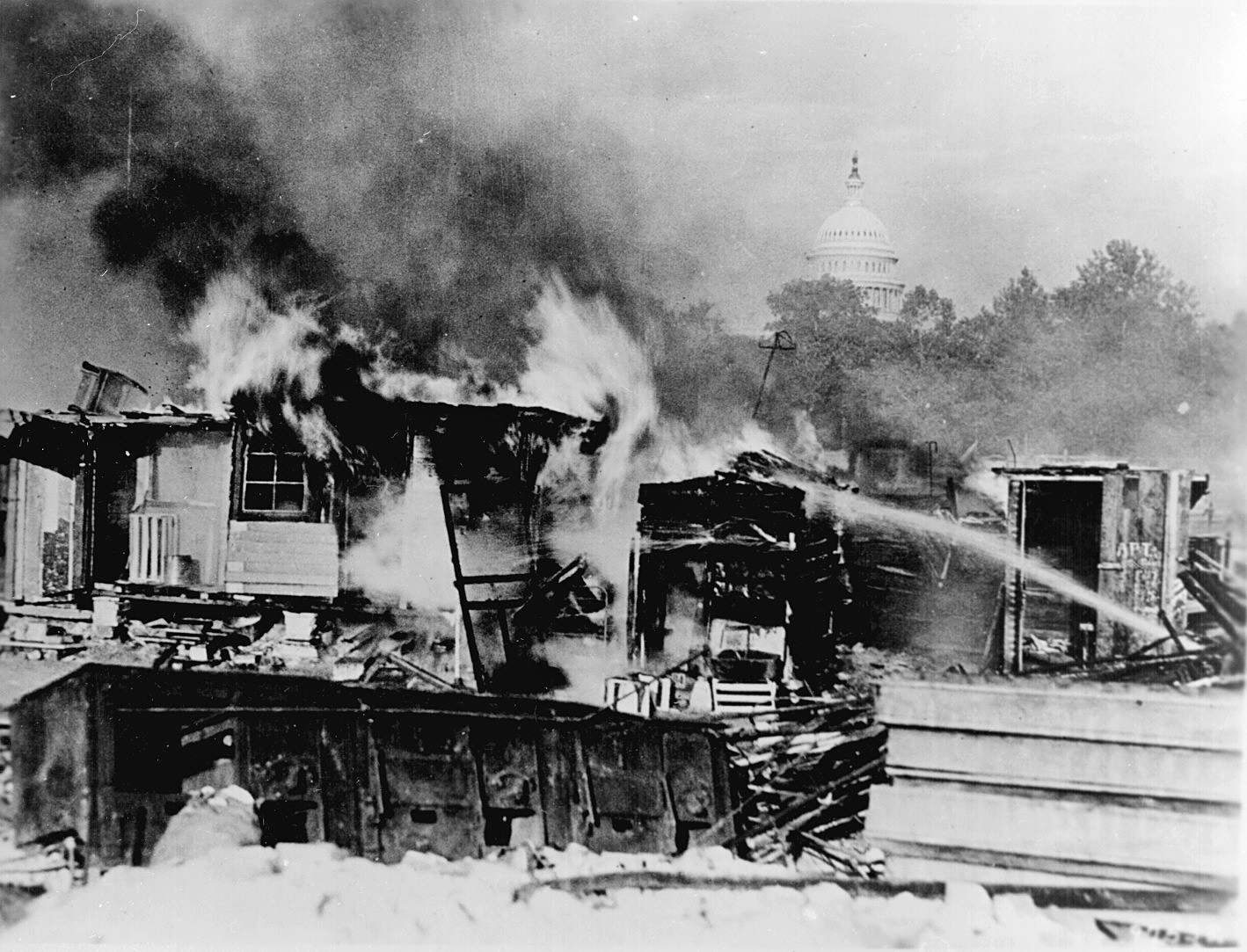
As the United States slid deeper into the Great Depression, individuals, families, and communities faced the frightening and bewildering failure of institutions on which they had depended. The fortunate were spared the worst effects, and a few even profited from it, but by the end of 1932 the crisis had become so deep and so widespread that most Americans had suffered directly. Facing unemployment and declining wages, Americans slashed expenses. The rich could survive by simply deferring vacations and regular consumer purchases. Middle- and working-class Americans might rely on credit at neighborhood stores, default on utility bills, or skip meals. Those who could borrowed from relatives or took boarders into their homes. Many poor families “doubled up” in tenements. The most desperate camped on public lands in “Hoovervilles,” spontaneous shantytowns that dotted America’s cities, depending on bread lines and street-corner peddling. The emotional and psychological shocks of unemployment only added to the material difficulties of the Depression. Social workers and charity officials often found the unemployed suffering from feelings of futility, anger, bitterness, confusion, and shame. These feelings affected the rural poor as well as the urban.
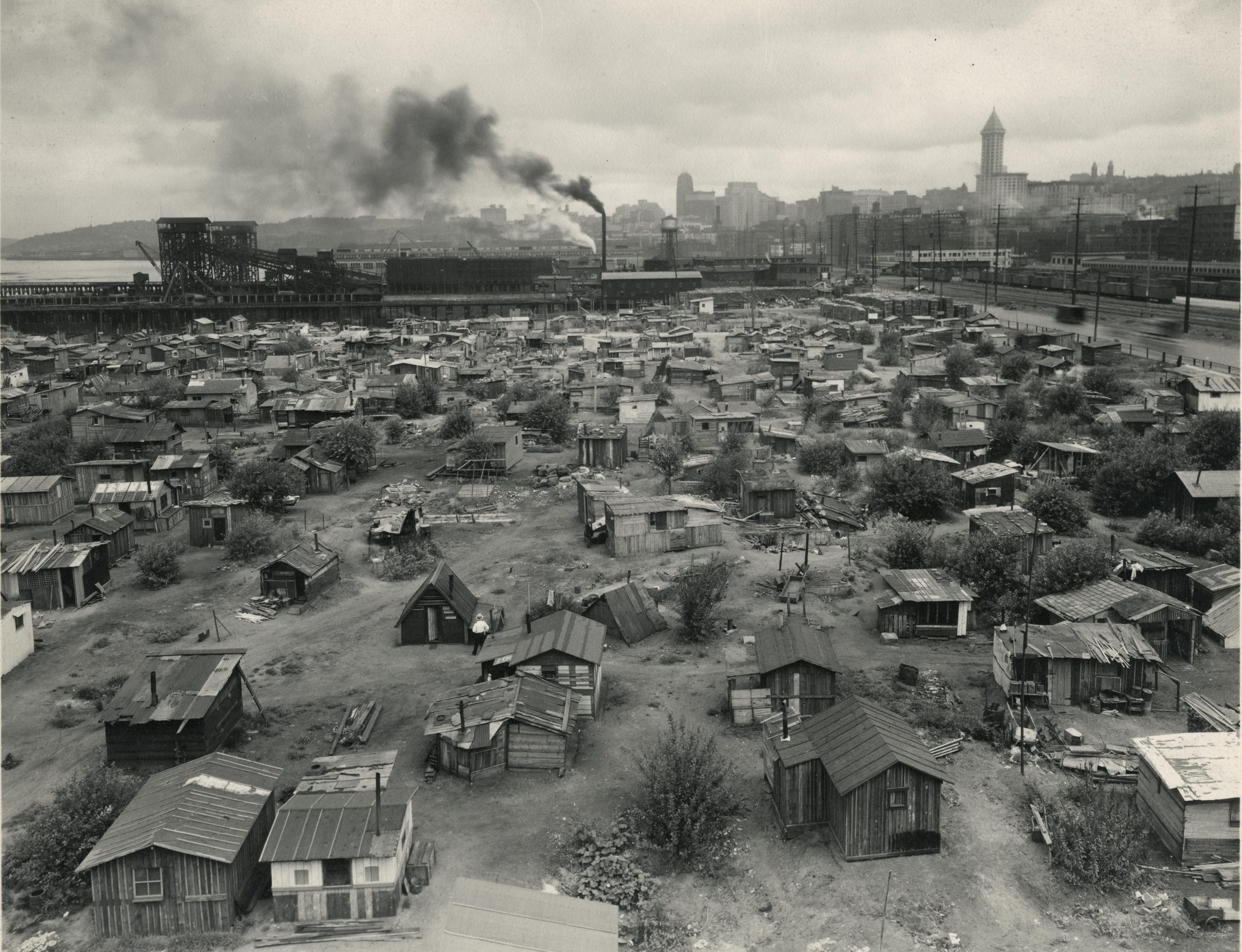
Question for Discussion
- Why was Hoover’s decision to attack the “Bonus Army” unwise?
The Dust Bowl
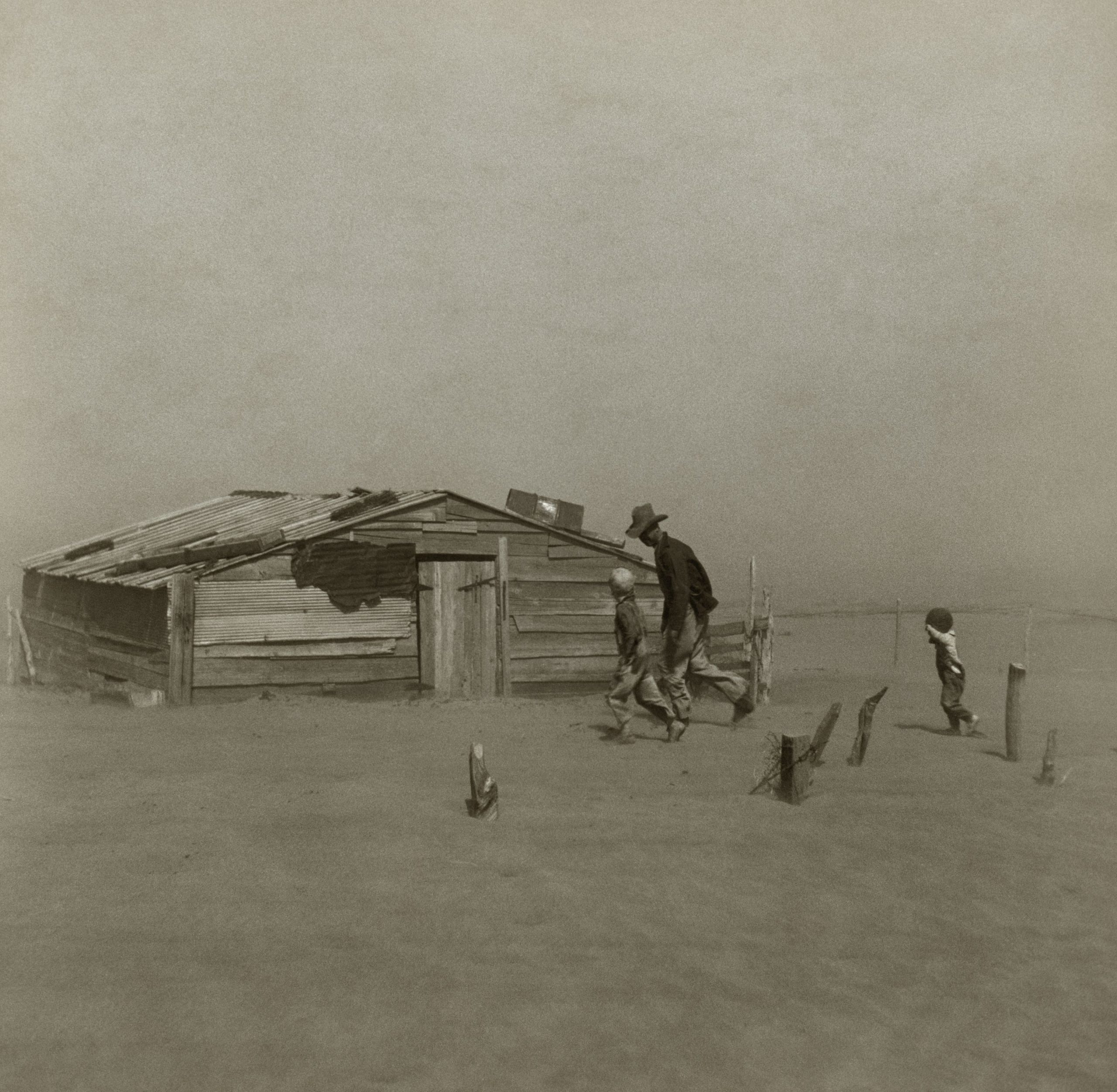
On the Great Plains, an environmental catastrophe exacerbated America’s longstanding agricultural crisis and magnified the Depression. The end of the World War had reduced demand for American farm products as European farmers gradually got back to work. This was a blow to the American farmers who had expanded production, often onto marginal lands in the west that had been typically used as rangeland for cattle. Then, beginning in 1932, severe droughts hit these newly-opened farmlands from Texas to the Dakotas. To grow additional crops, farmers had plowed up deep-rooted prairie grasses in the dry Plains states. Relatively wet conditions in the first decades of the twentieth century had protected them and farmers and agricultural boosters had convinced themselves that “Rain followed the plow.” But plowing western rangeland did not bring rain and shallow-rooted annual grain crops were unable to reach as deeply for water as the prairie grasses had. In the early 1930s, without rain, the exposed fertile topsoil turned to dust.
Without deep-rooted sod or windbreaks such as trees, winds churned the dust into massive storms that blotted out the sky, choked settlers and livestock, and rained dirt not only across the region but as far east as Washington, D.C., New England, and ships on the Atlantic Ocean. For example, in a single storm in November 1933, topsoil from Oklahoma was blown all the way to Chicago, where over 12 million pounds of it fell on the city like snow. On Black Sunday, April 14, 1935, dust storms were reported from the Canadian border to Texas. Newspaper reporters wrote that they could not see five feet through the blowing dust. The agricultural disaster that became known as the Dust Bowl caused an exodus from a region that should never have been put under the plow. But the disaster was not just just agricultural. Of 116,000 refugee families surveyed on their way into California, only four out of ten were farm families. A full third of the heads of families who fled Oklahoma, Kansas, Nebraska, and Texas were white collar professionals. When the farm soils blew away the whole region was wiped out. For many in Texas, Oklahoma, Kansas, and Arkansas who were “baked out, blown out, and broke,” their only hope was California, where there were still potential jobs for farmworkers. Oklahoma lost 440,000 people, or a full 18.4 percent of its 1930 population, to Dust Bowl migration.
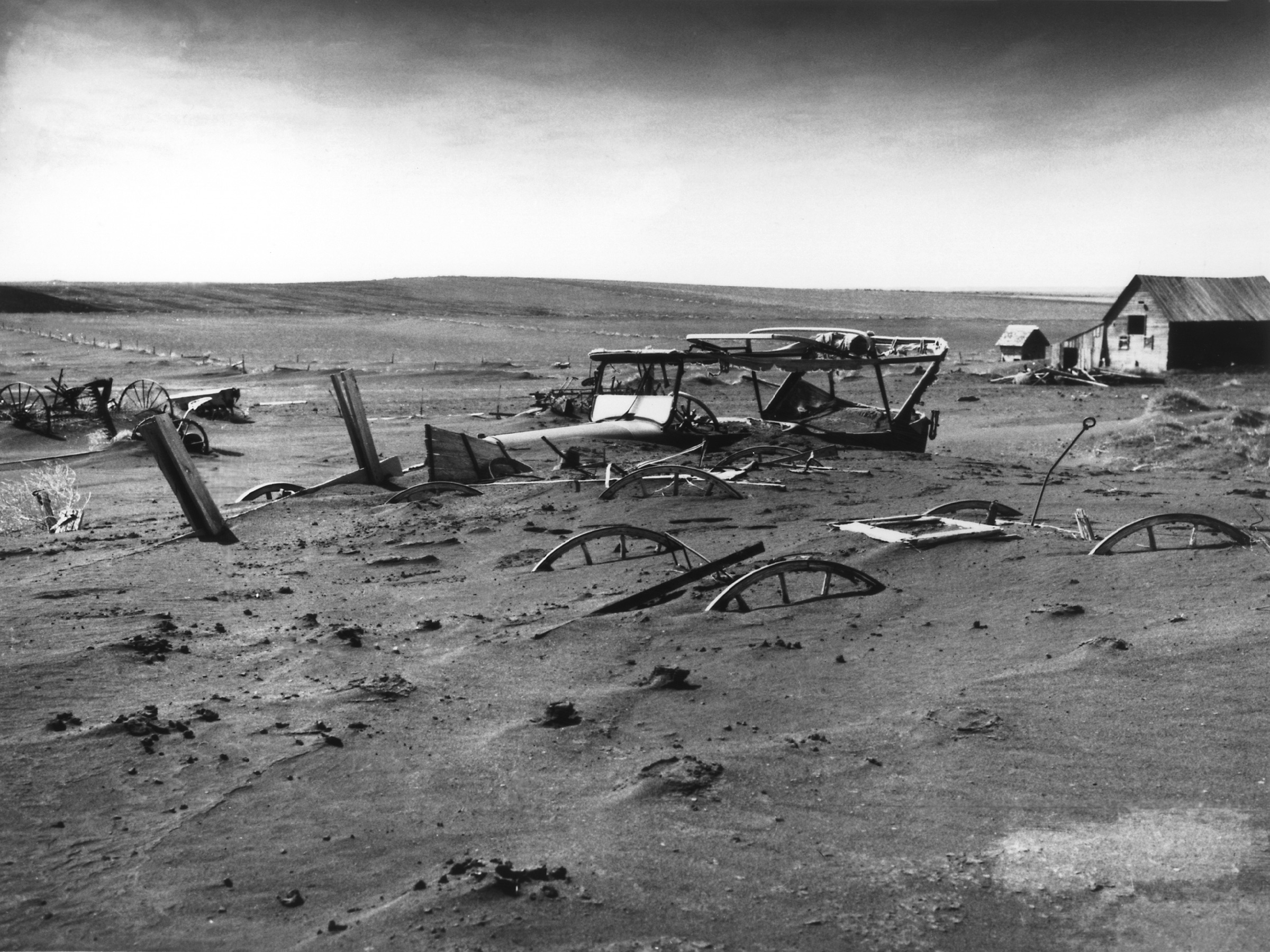
The Okies, as the refugees were disparagingly called by their new neighbors, were the most visible group on the move during the Depression, but not the only ones. By 1932, sociologists estimated that millions of men were on the roads and rails looking for work. Popular magazines and newspapers were filled with stories of homeless boys and the veterans-turned-hoboes of the Bonus Army commandeering boxcars. William Wellman’s 1933 film, Wild Boys of the Road and John Steinbeck’s The Grapes of Wrath, published in 1939, described the Depression’s dislocated populations. The 1930s saw a significant reversal in the flow of people between rural and urban areas. Thousands of people fled the jobless cities and moved to the country looking for work. As relief efforts floundered, many state and local officials tried to prevent migration, making it difficult for newcomers to receive relief or find work. Some states made it a crime to bring in poor migrants and allowed local officials to deport homeless migrants to neighboring states. In the winter of 1935–1936, California, Florida, and Colorado established “border blockades” to block refugees from entering their states and competing with locals for jobs. A billboard posted outside Tulsa, Oklahoma, informed potential migrants that there were “NO JOBS in California” and warned them to “KEEP OUT.”
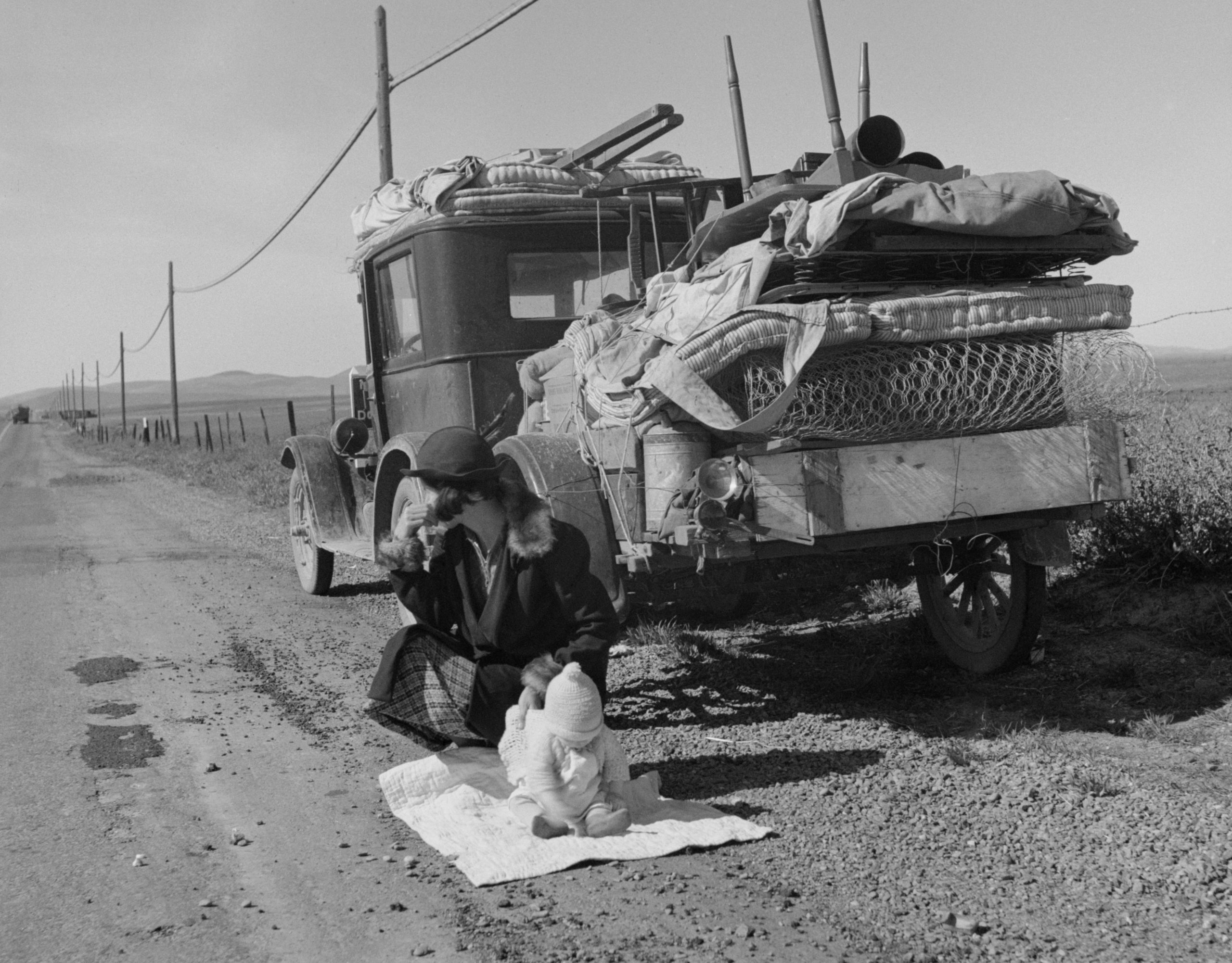
Sympathy for migrants, however, accelerated late in the Depression when Hollywood made a movie of The Grapes of Wrath. The Joad family’s struggles drew attention to the plight of Depression-era migrants and, just a month after the nationwide release of the film starring Henry Fonda in 1940, Congress created the Select Committee to Investigate the Interstate Migration of Destitute Citizens. Starting in 1940, the committee held widely publicized hearings.
Americans meanwhile feared foreign workers willing to work for even lower wages. The Saturday Evening Post warned that foreign immigrants, who were “compelled to accept employment on any terms and conditions offered,” would exacerbate the economic crisis. In September 1930, the Hoover administration had instructed consular officers to reject visa applications of those “likely to become public charges” and suggested that this might include denying visas to most, if not all, foreign workers and artisans. The number of European visas issued fell roughly 60 percent while deportations dramatically increased. Between 1930 and 1932, fifty-four thousand people were deported. An additional forty-four thousand deportable aliens left “voluntarily.” Exclusionary measures hit Mexican immigrants particularly hard. According to the federal census, from 1930 to 1940 the Mexican-born population living in Arizona, California, New Mexico, and Texas fell from 616,998 to 377,433. Franklin Roosevelt would not indulge anti-immigrant sentiment as willingly as Hoover had, and under the New Deal, the Immigration and Naturalization Service halted some of the Hoover administration’s most divisive practices. But with jobs suddenly scarce, hostile attitudes, and official policies less than welcoming, immigration plummeted and deportations rose. Over the course of the Depression, more people left the United States than entered it.
Questions for Discussion
- Why had so many people expanded farming in the western plains?
- How did most Americans feel about internal migrants and foreign immigrants?
Franklin Delano Roosevelt and the “First” New Deal
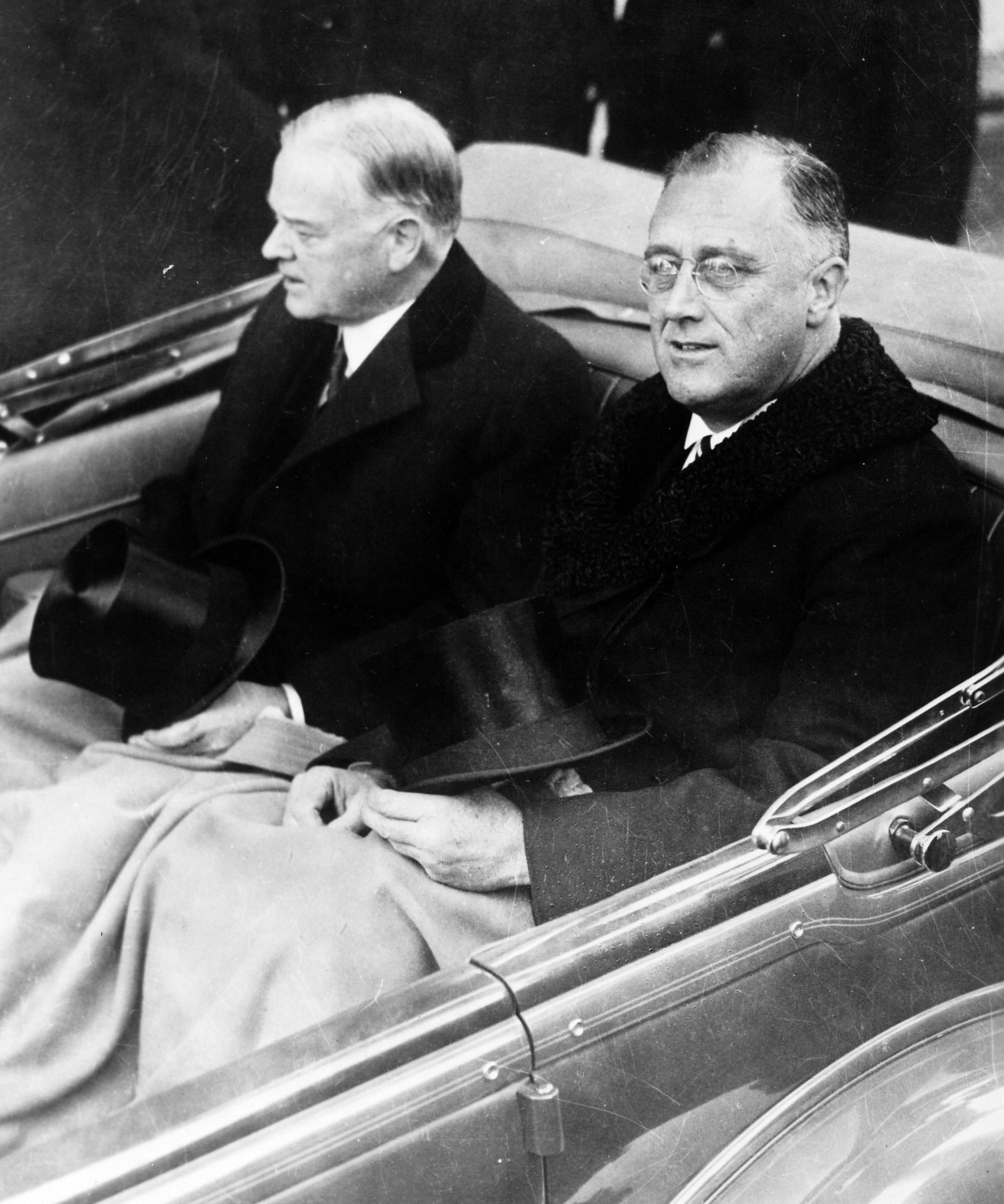
Under Herbert Hoover, the early years of the Depression were catastrophic. The crisis deepened each year. Unemployment peaked at 25 percent in 1932. With no end in sight and with private firms crippled and charities overwhelmed by the crisis, Americans looked to their government as the last defense against starvation, hopelessness, and perpetual poverty. Few presidential elections in modern American history have been more consequential than that of 1932. Exasperated voters overthrew Hoover in a landslide to elect the Democratic governor of New York, Franklin Delano Roosevelt. FDR was born into a very large and wealthy family in New York’s Hudson River Valley. His cousin, Theodore Roosevelt, was president while Franklin was at Harvard. Franklin married his fifth cousin, Eleanor Roosevelt, in 1905 and began a slow but steady rise through state and national politics. In 1913, he was appointed assistant secretary of the navy, a position he held during World War I. In the midst of this political rise, in the summer of 1921, Roosevelt was diagnosed with polio, a virus that affected millions throughout the world until a vaccine was developed in the 1950s. The disease left him a paraplegic but, encouraged and assisted by Eleanor, Roosevelt received treatment and maintained sufficient political connections to reenter politics. In 1928, Roosevelt won election as governor of New York. As governor, Roosevelt introduced the first comprehensive unemployment relief program and helped pioneer efforts to expand public utilities. He also relied on like-minded advisors. For example, Frances Perkins, then commissioner of New York’s labor department, improved workplace safety and reduced child labor in factories. Perkins later accompanied Roosevelt to Washington as America’s first female secretary of labor.
When he was nominated as the Democratic Party’s presidential candidate in July 1932, Roosevelt promised, “a new deal for the American people.” Newspaper editors seized on the phrase “new deal,” and it became shorthand for Roosevelt’s program to address the Great Depression. Roosevelt crushed Hoover, winning more counties than any previous candidate in American history. He spent the months between his election and inauguration traveling, planning, and assembling a team of advisors which became famous as Roosevelt’s “Brain Trust” of academics and experts. On March 4, 1933, in his first inaugural address, Roosevelt declared, “This great Nation will endure as it has endured, will revive and will prosper. So, first of all, let me assert my firm belief that the only thing we have to fear is fear itself—nameless, unreasoning, unjustified terror which paralyzes needed efforts to convert retreat into advance.” In his first days in office, Roosevelt and his advisors prepared, submitted, and passed laws designed to halt the worst effects of the Great Depression. His administration threw the federal government headlong into the fight against the Depression.
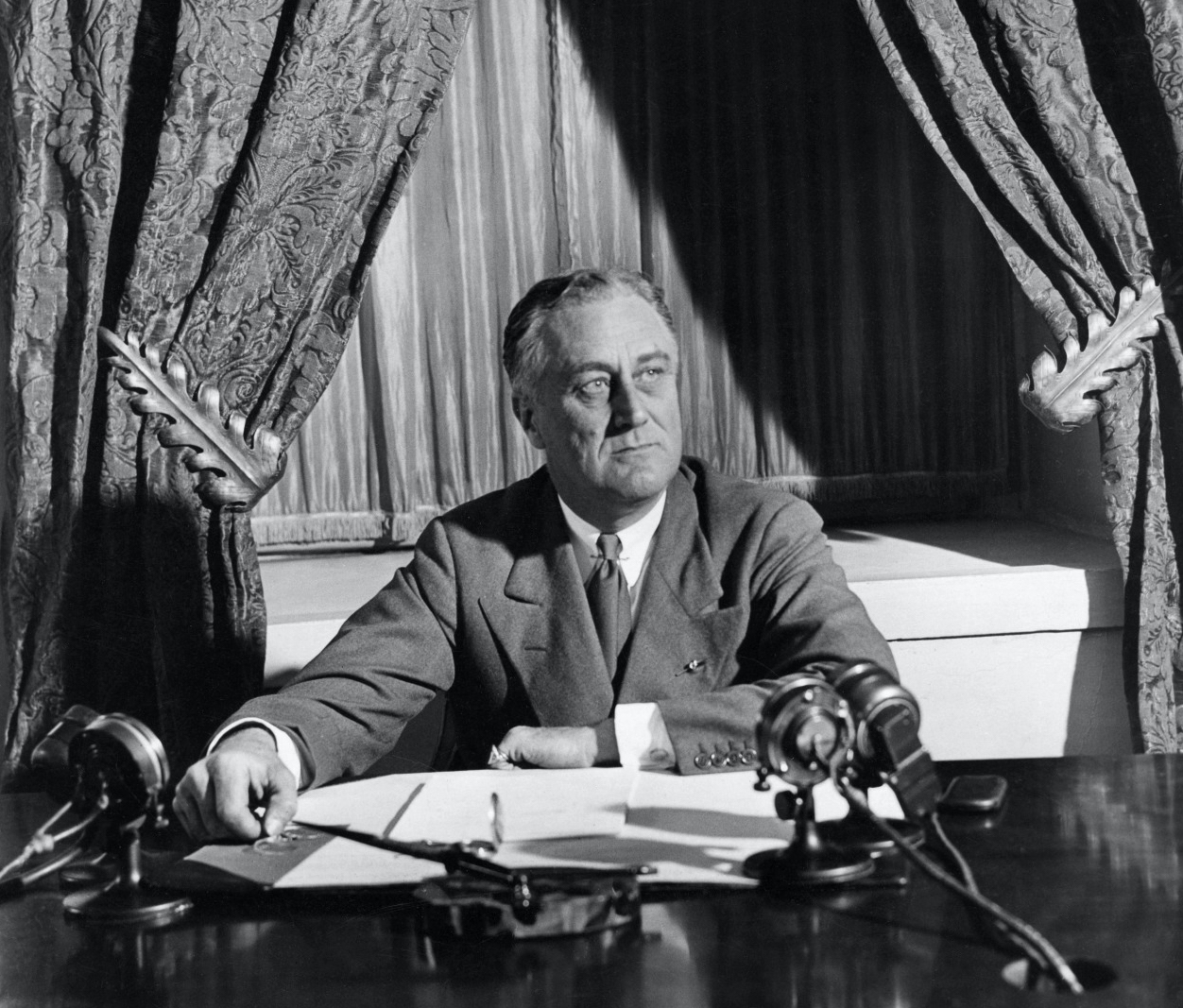
First, Roosevelt stabilized the collapsing banking system. Too many banks were being wiped out by runs, when panicked customers demanded their deposits in cash. The new president declared a national “bank holiday” closing American banks and pushed the Emergency Banking Act swiftly through Congress. On March 12, the night before select banks began reopening under stricter federal guidelines, Roosevelt spoke to Americans on the radio in the first of his Fireside Chats. These were broadcast addresses that the president continued delivering through his four terms. The tone of the thirty-one speeches was informal and Roosevelt used his airtime to explain New Deal legislation, to encourage confidence in government action, and to mobilize the American people’s support. In the first chat, Roosevelt described the new banking safeguards he had put in place and asked the public to trust their savings would be safe in banks. Americans responded and across the country, deposits outpaced withdrawals. The act was a major success. In June, Congress passed the Glass-Steagall Banking Act, which instituted federal deposit insurance and barred the mixing of commercial and investment banking.
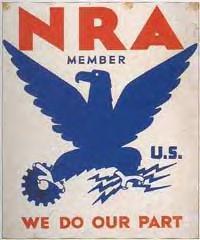
Stabilizing the banks was only a first step. In his First Hundred Days, Roosevelt and his congressional allies focused on relief for suffering Americans. Congress debated and amended, but generally passed the laws Roosevelt proposed. As one historian noted, the president “directed the entire operation like a seasoned field general.” Despite questions over the constitutionality of Roosevelt’s New Deal legislation, Americans and their representatives conceded that the crisis demanded swift and immediate action. The Civilian Conservation Corps (CCC) employed young men on conservation and reforestation projects, including 25,000 veterans from the Bonus Army. The Federal Emergency Relief Administration (FERA) provided direct cash assistance to state relief agencies struggling to care for the unemployed. The Tennessee Valley Authority (TVA) built a series of hydroelectric dams along the Tennessee River as part of a comprehensive program to economically develop a chronically depressed region. And several agencies helped home and farm owners refinance their mortgages.
The heart of Roosevelt’s early recovery program consisted of two massive efforts to stabilize and coordinate the American economy: the Agricultural Adjustment Administration (AAA) and the National Recovery Administration (NRA). The AAA, created in May 1933, aimed to raise the prices of agricultural commodities and boost farmers’ income by offering cash incentives to voluntarily limit farm production; decreasing supply and thus raising prices. The National Industrial Recovery Act (NIRA), which created the NRA in June 1933, suspended antitrust laws to allow businesses to establish “codes” that would coordinate prices, regulate production levels, and establish conditions of employment to curtail “cutthroat competition.” In exchange for these exemptions, businesses agreed to provide reasonable wages and hours, end child labor, and allow workers the right to unionize. Participating businesses earned the right to display a placard with the NRA’s Blue Eagle, showing their cooperation in the effort to combat the Great Depression.
The programs of the First Hundred Days stabilized the American economy and production began climbing once more. But even as output increased, unemployment remained stubbornly high. Though the unemployment rate dipped from its high of 25% in 1933, vast numbers remained out of work. If the private economy could not put enough people back to work, Roosevelt decided, the government would try. The Civil Works Administration (CWA) and the Works Progress Administration (WPA) put unemployed men and women to work on infrastructure projects designed by local governments. The Public Works Administration (PWA) provided grants-in-aid to local governments for large projects such as bridges, tunnels, schoolhouses, libraries, parks, and America’s first federal public housing projects. Together, they provided not only tangible projects of public good but employment for millions. The New Deal was reshaping much of the nation.
Questions for Discussion
- Why do you think Franklin Roosevelt called his plans a “New Deal” for the American people?
- Do you think the policies Roosevelt initiated were a radical change in federal involvement in the economy?
The New Deal in the South
The impact of New Deal legislation was quickly apparent in the South, where many regions of perpetual poverty were especially hard hit by the Depression. In 1929 the average per capita income in Southeastern states was $365, the lowest in the nation. Southern farmers earned on average $183 per year at a time when farmers on the West Coast made more than four times that. Worse, they were producing cotton and corn, crops that paid little while depleting the soil. And the little industry the South had remained low-wage, low-skilled, and primarily extractive. Southern workers made significantly less than their national counterparts: earning only 75% of non-southern textile workers’ wage rates, 60% of iron and steel workers, and just 45% of lumber workers. At the time of the stock market crash, southerners were already underpaid, underfed, and undereducated.
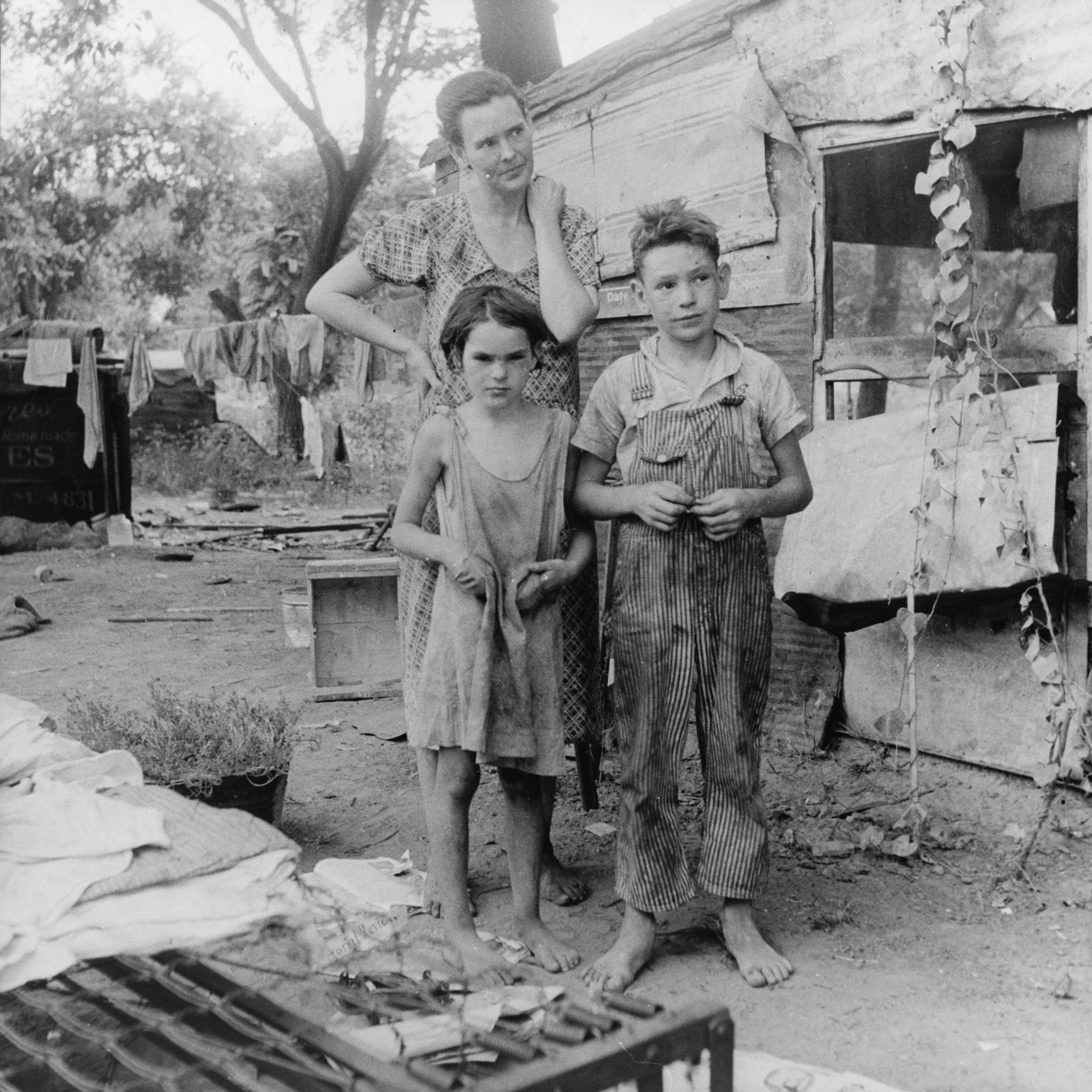
Several major New Deal programs were designed specifically with the South in mind. FDR hoped that by decreasing the amount of land devoted to cotton, the Agricultural Adjustment Act could arrest its long price decline. Farmers plowed up their cotton and left fields fallow, and the market price did rise. But in an agricultural world of landowners and landless farmworkers (tenants and sharecroppers), AAA policies benefitted the landowners and bypassed the poor southerners who needed them most. The government expected landowners and local organizations to distribute money fairly to those most affected by production limits, but many owners simply kicked tenants and sharecroppers off their land, took the subsidy checks for keeping those acres fallow, and reinvested the profits in mechanical farming equipment that further reduced the need for labor. Instead of making farming viable again for everyone involved, the AAA pushed landless southern farmworkers off the land. Many of these tenants and sharecroppers found jobs in Southern industry where the NRA encouraged higher wages and better conditions. The increased supply of workers began to suppress the rampant use of child labor in southern mills. And, for the first time, Roosevelt’s programs provided federal protection for unionized workers all across the country. Those protections were eventually solidified in the 1938 Fair Labor Standards Act, which set a national minimum wage of $0.25 per hour (eventually rising to $0.40). The minimum wage disproportionately affected low-paid southern workers and brought southern wages finally within the reach of northern wages.
The president’s support for unions had a very large impact in the South. Southern industrialists had been successful in preventing unionization, particularly in textile mills. In 1934, when workers at textile mills across the South struck for higher wages and shorter hours, owners turned to local and state authorities to attack workers’ groups and recruited thousands of strikebreakers from the displaced farmers swelling industrial centers looking for work. But in 1935 the National Labor Relations Act, also known as the Wagner Act, guaranteed the rights of most workers to unionize and bargain collectively. Southern workers, backed by the federal government and determined to participate in the reforms of the New Deal, pushed for higher wages, shorter hours, and better conditions. Union members came to see Roosevelt as a protector of workers’ rights or, as one union leader put it, an “agent of God.”
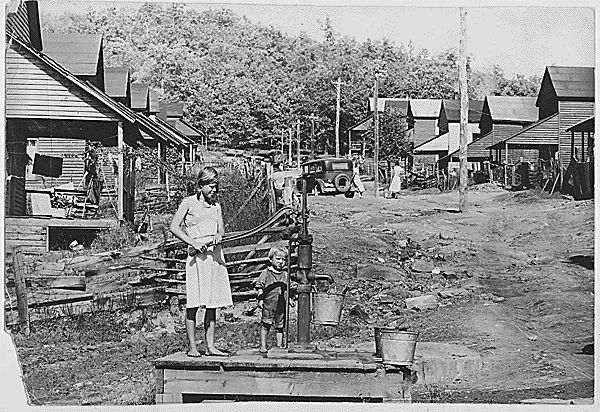
Perhaps the most successful New Deal program in the South was the TVA, an ambitious program to use hydroelectric power, agricultural and industrial reform, flood control, economic development, education, and healthcare to radically remake the impoverished Tennessee River Valley. Roosevelt’s TVA sought to “make a different type of citizen” out of the area’s penniless residents. The TVA built a series of hydroelectric dams to control flooding and distribute electricity to remote rural areas at government-subsidized rates. Rural electrification had been slow to catch on because of the cost of running wire to remote homes. The TVA accelerated the process and helped set an expectation of electrified modern life for many country people. Agents of the TVA also met with residents and offered training to improve agricultural practices and exploit new job opportunities. The TVA encapsulated Roosevelt’s vision for uplifting the South and rural America and integrating it into the larger national economy.
Roosevelt needed to court conservative southern Democrats to ensure the legislative success of the New Deal, which meant that the racial and economic inequalities of the region remained intact. By the end of his second term, FDR had won the support of enough non-southern voters that he felt more confident confronting some of the region’s most glaring inequalities. This change was apparent in his endorsement of a report titled “A Report on Economic Conditions in the South” that criticized inequities and attacked reactionary southern anti–New Dealers. In his introduction to the report, Roosevelt called the region “the Nation’s No. 1 economic problem”. The report was one of the first elements of Roosevelt’s reelection campaign that addressed the inequalities that continued in southern and national life.
The New Deal also addressed Appalachia, the poverty-stricken region that roughly follows the mountains from southern New York to the foothills of Alabama and Mississippi. The region’s abundant natural resources, including timber and coal, had been in high demand since the post–Civil War industrial expansion, but Appalachian industry typically extracted these resources for the profit of far-off owners, depressing the coal-producing areas even earlier than the rest of the country. By the mid-1930s, with the Depression suppressing demand, residents were stranded in small, isolated communities whose few businesses stood on the verge of collapse. Relief workers from FERA reported serious shortages of medical care, shelter, clothing, and food. Preventable illnesses including typhus, tuberculosis, pneumonia, and venereal disease, as well as childhood malnutrition, further crippled Appalachia.
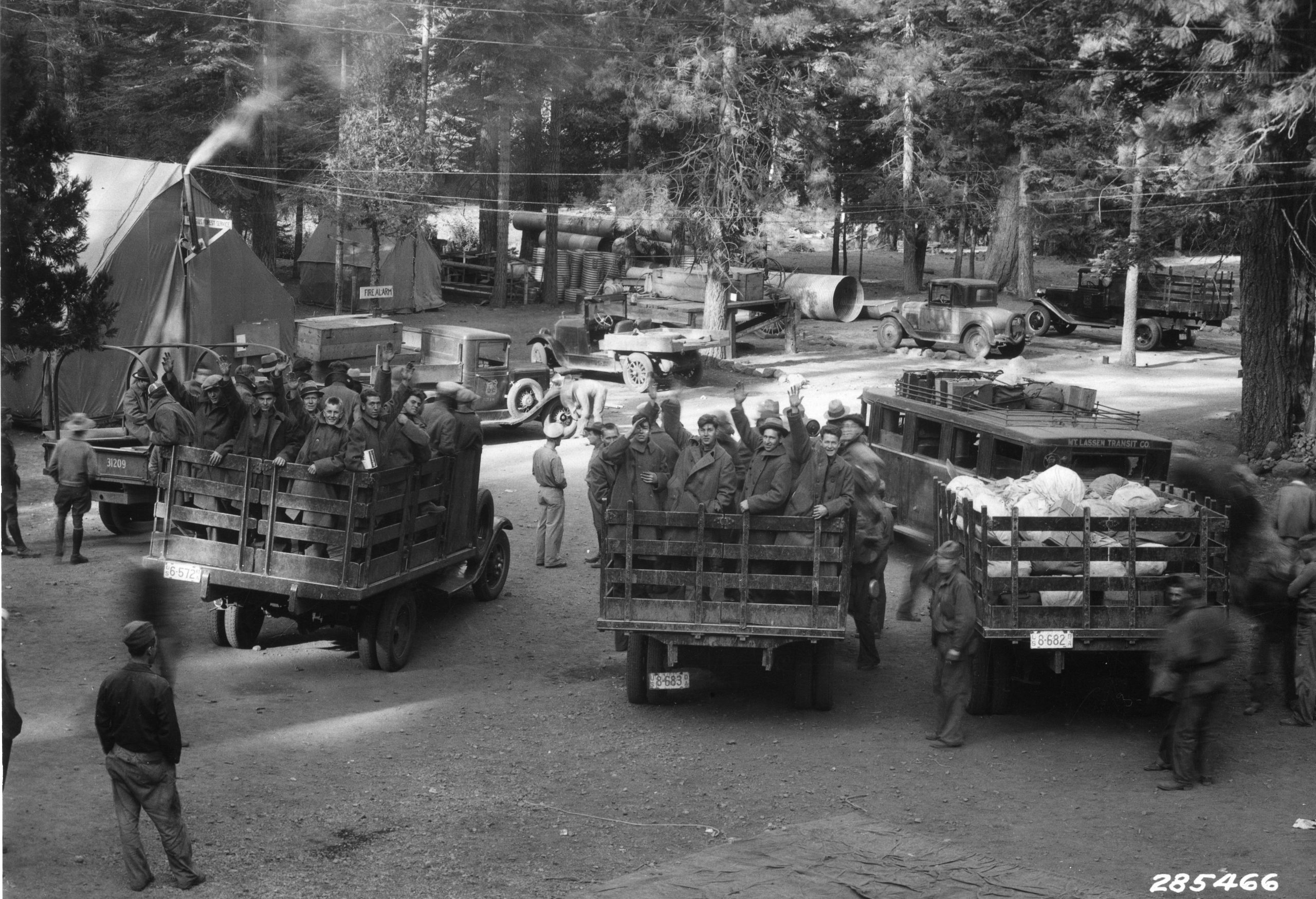
Several New Deal programs targeted the region. Roosevelt established the Division of Subsistence Homesteads (DSH) within the Department of the Interior to give poor families an opportunity to relocate “back to the land”. The DSH established thirty-four homestead communities nationwide, including the Appalachian regions of Alabama, Pennsylvania, Tennessee, and West Virginia. The CCC contributed to projects throughout Appalachia, including building the Blue Ridge Parkway in North Carolina and Virginia, reforesting the Chattahoochee National Forest in Georgia, and improving state parks such as Pine Mountain Resort State Park in Kentucky. The TVA’s efforts aided communities in Tennessee and North Carolina, and the Rural Electric Administration (REA) brought electricity to 288,000 rural households.
Question for Discussion
- Why was the TVA considered a monumental undertaking?
Roosevelt’s Critics
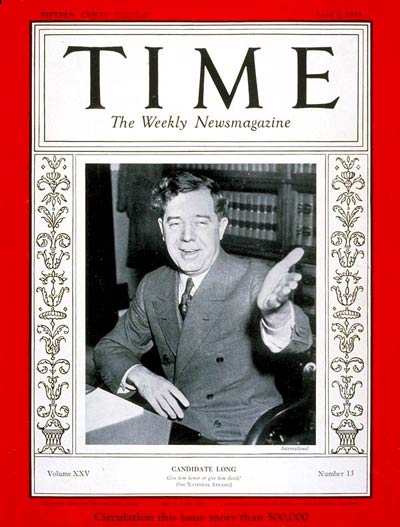
Despite the unprecedented actions he took in his first year in office, Franklin Roosevelt’s approach to combatting the Great Depression was not unanimously supported. Some critics found FDR’s relief programs too conservative. He had been careful to work within the limits of presidential authority and congressional cooperation. And unlike Europe, where several nations had turned toward state-run economies, fascism, and socialism, Roosevelt’s New Deal showed his reluctance to radically alter America’s foundational economic and social structures. Many high-profile critics attacked Roosevelt for not going far enough. Senator Huey Long, a flamboyant Democrat from Louisiana, may have been the loudest “voice of protest.” Long’s populist rhetoric appealed to people who saw deeply-rooted injustice in the nation’s economic system. Long proposed a “Share Our Wealth” program, saying the federal government should confiscate the assets of the extremely wealthy and redistribute them through guaranteed minimum incomes (what we might now call UBI). “How many men ever went to a barbecue and would let one man take off the table what’s intended for nine-tenths of the people to eat?” he asked. Over 27,000 Share the Wealth clubs sprang up as Long traveled the country explaining his program to crowds of unemployed Americans. Long planned the movement to be a stepping-stone to a run for the presidency, but his crusade ended in late 1935 when he was assassinated at the Louisiana state capitol. Even in death, however, Long convinced Roosevelt to more actively attack the Depression and American inequality.
While many Americans urged Roosevelt to go further in addressing the economic crisis, the president faced even greater opposition from conservative politicians and business leaders. By late 1934, complaints increased from business-friendly Republicans about Roosevelt’s willingness to regulate industry and use federal spending for public works and employment programs. In the South, Democrats who had originally supported the president grew more hostile toward programs that challenged the region’s political and social status quo. Yet the greatest opposition came from the Supreme Court, which was dominated by conservative judges appointed during the long years of Republican presidents. By early 1935 the Court had begun reviewing programs of the New Deal. On May 27, a day Roosevelt’s supporters called Black Monday, the justices struck down one of the president’s signature reforms. In a case revolving around poultry processing, the Court unanimously declared the NRA unconstitutional. In early 1936, the AAA fell as well.
The “Second” New Deal
Running for reelection and facing rising opposition from both the left and the right, Roosevelt adopted a more radical, aggressive approach to poverty, which became known as the Second New Deal. In 1935, hoping to reconstitute some of the protections for workers in the defunct NRA, Roosevelt worked with Congress to pass the National Labor Relations Act. The new law created a National Labor Relations Board (NLRB) offering federal legal protection, for the first time, for workers to organize unions. Three years later, Congress passed the Fair Labor Standards Act, creating the modern minimum wage. The Second New Deal also restored a highly progressive federal income tax, mandated new reporting requirements for publicly traded companies, refinanced long-term home mortgages for struggling homeowners, and created rural reconstruction projects to bring farm incomes in line with urban ones.
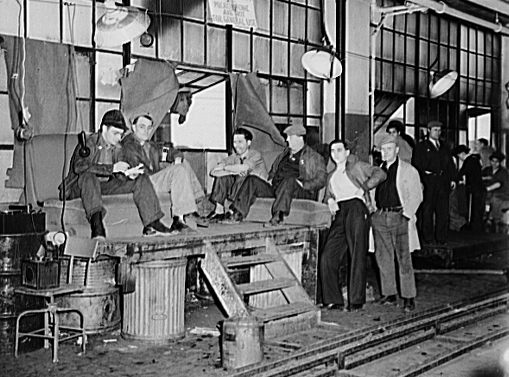
In northern industrial cities, labor had responded to worsening conditions by banding together and demanding support for workers’ rights. In 1935, the head of the United Mine Workers, John L. Lewis, broke away from the conservative, craft-oriented American Federation of Labor (AFL) to form the Congress of Industrial Organizations (CIO). The CIO won a major victory in 1937 when affiliated members in the United Automobile Workers (UAW) struck for recognition and better pay and hours at a General Motors (GM) plant in Flint, Michigan. In the first instance of a “sit-down” strike, the workers remained in the building until management agreed to negotiate. GM recognized the UAW and the “sit-down” strike became a new weapon in the fight for workers’ rights. Across the country, unions and workers took advantage of the New Deal’s labor protections to organize and win major concessions from employers.
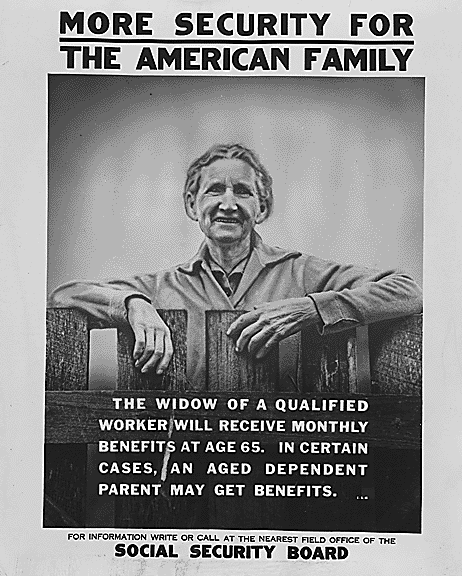
The signature piece of Roosevelt’s Second New Deal came the same year. The 1935 Social Security Act provided for old-age pensions, unemployment insurance, and economic assistance for both the elderly and dependent children. The president was careful to mitigate some of the criticism of what was, at the time, a revolutionary concept. He specifically insisted that Social Security must be financed through a payroll tax, not by federal government grants. “No dole,” Roosevelt said repeatedly; Social Security “mustn’t have a dole.” This distinction helped separate the program from the stigma of being an undeserved “welfare” entitlement. Social Security allowed older workers to retire, opening jobs for younger workers. It became the centerpiece of the modern American social welfare state.
Questions for Discussion
- Why did Roosevelt’s critics believe his initiatives were unconstitutional?
- How did Roosevelt respond to defeat?
Equal Rights and the New Deal
The Great Depression was particularly tough for nonwhite Americans. An old black man told interviewer Studs Terkel, “The Negro was born in depression. It didn’t mean too much to him. The Great American Depression . . . only became official when it hit the white man.” In 1932, with the national unemployment at 25 percent, black unemployment reached as high as 50 percent, while black workers who kept their jobs saw their already low wages cut dramatically. African Americans faced discrimination everywhere but suffered especially severe inequality in the Jim Crow South. In 1931, for instance, a group of nine young men riding the rails between Chattanooga and Memphis, Tennessee, were pulled from the train near Scottsboro, Alabama, and charged with assaulting two white women. Despite clear evidence that the assault had not occurred and despite one of the women later recanting, the young men faced a series of sham trials in which all but one were sentenced to death. Only the communist International Legal Defense (ILD) came to the aid of the “Scottsboro Boys,” who soon became a national symbol of continuing racism in America and a rallying point for civil rights activists. In appeals, the ILD successfully challenged the convictions and the death sentences were either commuted or reversed, although the last of the accused did not receive parole until 1946.
Franklin Roosevelt did little to directly address the difficulties black communities faced. FDR believed that if he supported civil rights openly he would provoke southern Democrats and put his New Deal coalition at risk. Roosevelt not only rejected proposals such as abolishing the poll tax and declaring lynching a federal crime, he refused to specifically target African American needs in any of his larger relief and reform packages. As he explained to the national secretary of the NAACP, “I just can’t take that risk.”
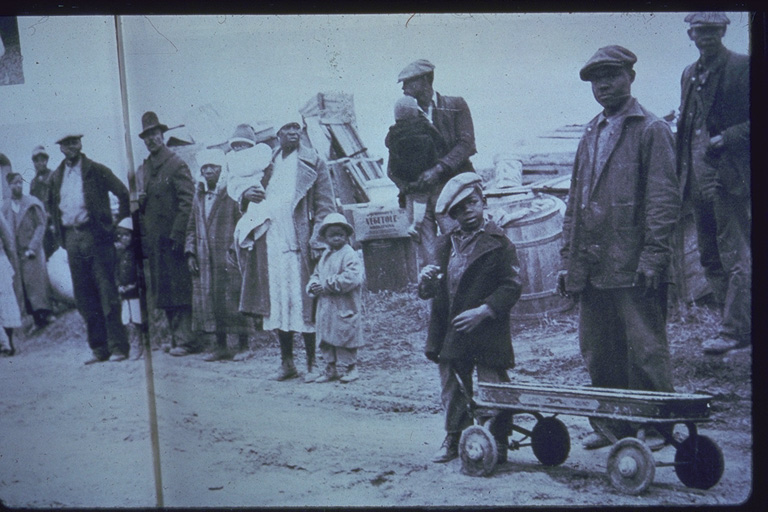
Perhaps the worst failure of the New Deal to aid African Americans came with the passage of the Social Security Act. Southern politicians worried that economic security would allow black southerners to escape the cycle of poverty that kept them tied to the land as cheap, exploitable farm laborers. The Jackson Daily News complained that “The average Mississippian can’t imagine himself chipping in to pay pensions for able-bodied Negroes to sit around in idleness . . . while cotton and corn crops are crying for workers.” Roosevelt agreed to remove domestics (maids) and farm laborers from the provisions of the bill, excluding many African Americans from the benefits of an expanding economic safety net.
Women, too, failed to receive the full benefits of New Deal programs. On one hand, Roosevelt included women in key positions within his administration, including the first female cabinet secretary, Frances Perkins. First Lady Eleanor Roosevelt was a key advisor to the president and became a major voice for economic and racial justice. But many New Deal programs were built on the assumption that men would be the breadwinners and women mothers, homemakers, and consumers. New Deal programs aimed to help both men and women in the context of families, but these gendered assumptions made it difficult for some women to attain economic autonomy. So despite great advances, the New Deal was unable to eliminate core inequalities of life in the United States.
Question for Discussion
- Why was Roosevelt unsuccessful making more benefits of the New Deal available to African Americans and women?
Legacy of the New Deal
By 1936 Roosevelt and his New Deal were extremely popular and in November Roosevelt easily beat his challenger, Governor Alf Landon of Kansas, winning in every state but Maine and Vermont. The Great Depression had certainly not ended, but hard times appeared to be in a slow yet steady retreat. Roosevelt was ready to take advantage of both his popularity and the improving economic climate to press for even more dramatic changes. But conservative opponents limited the power of FDR’s popular support. The Supreme Court continued to gut many of his programs. In 1937, worried that the Court might overturn Social Security, Roosevelt called for legislation to expand the Court by appointing a new, younger justice for every sitting member over age seventy. The president argued that the measure would speed up the Court’s ability to handle a growing backlog of cases. But this “court-packing scheme,” as opponents termed it, was clearly designed to allow the FDR to appoint up to six friendly, pro–New Deal justices to counteract the influence of the old conservatives on the Court. Roosevelt’s “scheme” did not become law, but the Court upheld social security and other pieces of New Deal legislation. In any case, Roosevelt was able to appoint more amenable justices as the conservatives died or retired.
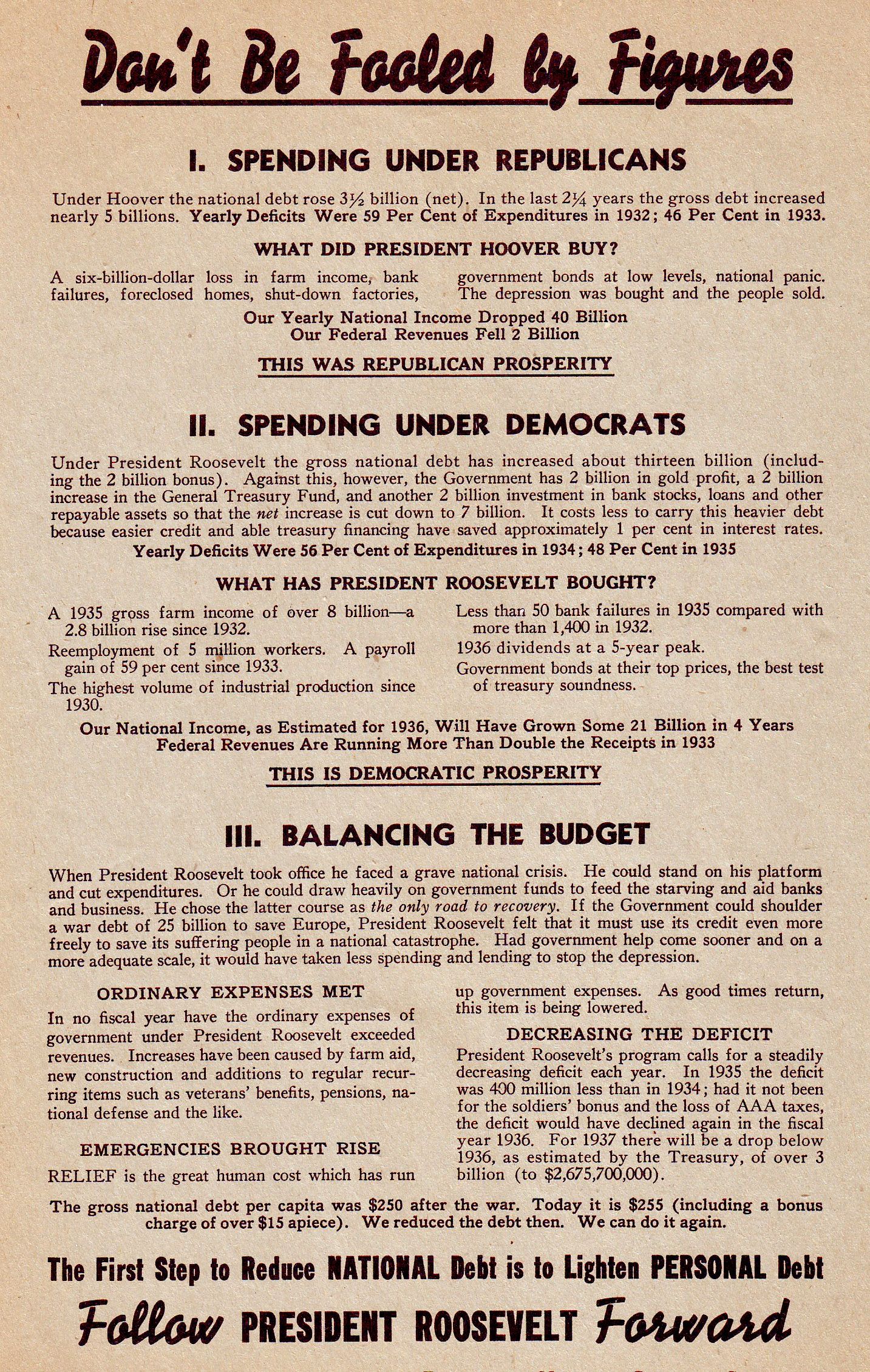
By the end of the 1930s, Roosevelt and his Democratic Congresses had transformed American government and realigned politics. Before World War I, the American federal government had been a “government out of sight.” After the New Deal, Americans came to see the federal government as a potential ally in their daily struggles finding work, securing a decent wage, getting a fair price for agricultural products, or organizing unions. Voter turnout in presidential elections jumped in 1932 and again in 1936, with most of these newly mobilized voters forming a progressive wing of the Democratic Party that would remain loyal well into the 1960s. Even as affluence returned with American involvement in World War II, memories of the Depression continued to shape the outlook of two generations of Americans. Survivors of the Great Depression and their children the “baby boomers” would not quickly forget the hard times or the fact that government had helped end them. Historians debate when the New Deal ended. Some identify the Fair Labor Standards Act of 1938 as the last major New Deal legislation. Others see wartime measures such as price and rent control and the post-war G.I. Bill that guaranteed benefits to veterans as New Deal policies. Still others describe a “New Deal order,” a set of “ideas, public policies, and political alliances,” that guided American politics from Roosevelt’s Hundred Days to Lyndon Johnson’s Great Society and perhaps even beyond. Today the New Deal’s legacy echoes in calls for a Green New Deal, and its battle lines still shape American politics.
Question for Discussion
- How effective do you think Roosevelt’s policy was, of taking his message directly to the American people through “fireside chats” and posters like the one above?
Primary Sources
Herbert Hoover on the New Deal (1932)
Americans elected a string of conservative Republicans to the presidency during the boom years of the 1920s. When the economy crashed in 1929, however, and the nation descended deeper into the Great Depression, voters abandoned the Republican Party and conservative politicians struggled to in office. In this speech on the eve of the 1932 election, Herbert Hoover warned against Franklin Roosevelt’s proposed New Deal.
Huey P. Long, “Every Man a King” and “Share our Wealth” (1934)
Amid the economic indignities of the Great Depression, Huey P. Long of Louisiana championed an aggressive program of public spending and wealth redistribution. Critics denounced Long, who served as both governor and a senator from Louisiana, as a corrupt demagogue, but “the Kingfish” appealed to impoverished Louisianans and Americans wracked by joblessness and resentful of American economic inequality. He was assassinated before he could mount his independent bid for the White House in 1936. In the following extracts from two of his most famous speeches, Long outlines his political program.
Franklin Roosevelt’s Re-Nomination Acceptance Speech (1936)
In July 27, 1936, President Franklin Roosevelt accepted his re-nomination as the Democratic Party’s presidential choice. In his acceptance speech, Roosevelt laid out his understanding of what “freedom” and “tyranny” meant in an industrial democracy.
Second Inaugural Address of Franklin D. Roosevelt (1937)
After winning a landslide victory in his 1936 quest for a second presidential term, President Franklin Roosevelt championed again the ambitious goals of his New Deal economic programs and their relationship to American democracy.
Lester Hunter, “I’d Rather Not Be on Relief” (1938)
Lester Hunter left the Dust Bowl for the fields of California and wrote this poem, later turned into a song by migrant workers in California’s Farm Security Administration camps. The “C.I.O.” in the final line refers to the Congress of Industrial Unions, a powerful new industrial union founded in 1935.
Family Walking on Highway (1936)
During her assignment as a photographer for the Works Progress Administration (WPA), Dorothea Lange documented the movement of migrant families forced from their homes by drought and economic depression. This family was in the process of traveling 124 miles by foot, across Oklahoma, because the father was unable to receive relief or WPA work of his own due to an illness.
This short newsreel clip made by British film company Pathé shows the federal government’s response to the thousands of WWI veterans who organized in Washington DC during the summer of 1932 to form what was called a “Bonus Army.” At the demand of attorney general, the marchers were violently removed from government property.
Reference Material
This chapter was adapted by Dan Allosso from Chapter 23 of The American Yawp, including edited content from the original chapter and original material. The Yawp chapter was edited by Matthew Downs, with content contributed by Dana Cochran, Matthew Downs, Benjamin Helwege, Elisa Minoff, Caitlin Verboon, and Mason Williams.
Recommended Reading
- Balderrama, Francisco E., and Raymond Rodríguez.Decade of Betrayal: Mexican Repatriation in the 1930s, rev. ed. Albuquerque: University of New Mexico Press, 2006.
- Brinkley, Alan. The End of Reform: New Deal Liberalism in Recession and War.New York: Knopf, 1995.
- ———. Voices of Protest: Huey Long, Father Coughlin, and the Great Depression.New York: Knopf, 1982.
- Cohen, Lizabeth. Making a New Deal: Industrial Workers in Chicago, 1919–1939.New York: Cambridge University Press, 1990.
- Cowie, Jefferson, and Nick Salvatore. “The Long Exception: Rethinking the Place of the New Deal in American History.” International Labor and Working-Class History74 (Fall 2008): 1–32.
- Dickstein, Morris. Dancing in the Dark: A Cultural History of the Great Depression.New York: Norton, 2009.
- Fraser, Steve, and Gary Gerstle, eds. The Rise and Fall of the New Deal Order, 1930–1980.Princeton, NJ: Princeton University Press, 1989.
- Gilmore, Glenda E. Defying Dixie: The Radical Roots of Civil Rights, 1919–1950.New York: Norton, 2009.
- Gordon, Colin. New Deals: Business, Labor, and Politics in America 1920–1935.New York: Cambridge University Press, 1994.
- Gordon, Linda. Dorothea Lange: A Life Beyond Limits.New York: Norton, 2009.
- ———. Pitied but Not Entitled: Single Mothers and the History of Welfare 1890–1935.New York: Free Press, 1994.
- Greene, Alison Collis. No Depression in Heaven: The Great Depression, the New Deal, and the Transformation of Religion in the Delta.New York: Oxford University Press, 2015.
- Katznelson, Ira. Fear Itself: The New Deal and the Origins of Our Time.New York: Norton, 2013.
- Kelly, Robin D. G. Hammer and Hoe: Alabama Communists During the Great Depression. Chapel Hill: University of North Carolina Press, 1990.
- Kennedy, David. Freedom from Fear: America in Depression and War, 1929–1945.New York: Oxford University Press, 1999.
- Kessler-Harris, Alice. In Pursuit of Equity: Women, Men, and the Quest for Economic Citizenship in 20th-Century America.New York: Oxford University Press, 2003.
- Leach, William. Land of Desire: Merchants, Power, and the Rise of a New American Culture.New York: Pantheon Books, 1993.
- Leuchtenburg, William. Franklin Roosevelt and the New Deal, 1932–1940.New York: Harper and Row, 1963.
- Pells, Richard. Radical Visions and American Dreams: Culture and Social Thought in the Depression Years.New York: Harper and Row, 1973.
- Phillips, Kimberly L. Alabama North: African-American Migrants, Community and Working-Class Activism in Cleveland, 1915-1945.Champaign: University of Illinois Press, 1999.
- Phillips–Fein, Kim. Invisible Hands: The Businessmen’s Crusade Against the New Deal.New York: Norton, 2010
- Sitkoff, Harvard. A New Deal for Blacks: The Emergence of Civil Rights as a National Issue. New York: Oxford University Press, 1978.
- Sullivan, Patricia. Days of Hope: Race and Democracy in the New Deal Era.Chapel Hill: University of North Carolina Press, 1996.
- Tani, Karen. States of Dependency: Welfare, Rights, and American Governance, 1935–1972. Cambridge, UK: Cambridge University Press, 2016.
- Wright, Gavin. Old South, New South: Revolutions in the Southern Economy Since the Civil War.Baton Rouge: LSU Press, 1986.
Media Attributions
- 2560px-Lange-MigrantMother02 © Dorothea Lange is licensed under a Public Domain license
- Crowd_outside_nyse © Unknown is licensed under a Public Domain license
- Harga_Saham_Wall_Street_1929_-_1932_menjunam © Encik Tekateki is licensed under a CC BY-SA (Attribution ShareAlike) license
- Unemployed_men_queued_outside_a_depression_soup_kitchen_opened_in_Chicago_by_Al_Capone,_02-1931_-_NARA_-_541927 © U.S. Information Agency is licensed under a Public Domain license
- 2880px-Bank_Run_on_American_Union_Bank © Unknown is licensed under a Public Domain license
- President_Hoover_portrait © Unknown is licensed under a Public Domain license
- Bonus_army_on_Capitol_lawn_cph.3a00515 © Underwood & Underwood is licensed under a Public Domain license
- Evictbonusarmy © Signal Corps Photographer is licensed under a Public Domain license
- 1467AE20F9482CB146094D5A3DED58CF © Warner, H.M. is licensed under a Public Domain license
- Farmer_walking_in_dust_storm_Cimarron_County_Oklahoma2 © Arthur Rothstein is licensed under a Public Domain license
- Dust_Bowl_-_Dallas,_South_Dakota_1936 © USDA is licensed under a Public Domain license
- _Broke,_baby_sick,_and_car_trouble!__-_Dorothea_Lange’s_photo_of_a_Missouri_family_of_five_in_the_vicinity_of_Tracy,_California © Dorothea Lange is licensed under a Public Domain license
- FDR_Inauguration_1933 © Architect of the Capitol is licensed under a Public Domain license
- FDR-March-12-1933 © Unknown is licensed under a Public Domain license
- NewDealNRA © US Govt. is licensed under a Public Domain license
- Poor_mother_and_children,_Oklahoma,_1936_by_Dorothea_Lange © Dorothea Lange is licensed under a Public Domain license
- TVA_water_supply_Wilder © Unknown is licensed under a Public Domain license
- CCC_boys_leaving_camp_for_home,_Lassen_National_Forest,_California_(3226900020) © Unknown is licensed under a Public Domain license
- Time_Magazine_-_Huey_Long © Time Magazine is licensed under a Public Domain license
- Flint_Sit-Down_Strike_window © Sheldon Dick is licensed under a Public Domain license
- SocialSecurityposter1 © U.S. Govt. is licensed under a Public Domain license
- Sharecroppers_evicted_1936 © Unknown is licensed under a Public Domain license
- 1936_FDR__Don’t_Be_Fooled_by_Figures__Re-election_handbill © Democratic National Campaign Committee is licensed under a Public Domain license

